French Line - S.S. Normandie 1935-1941 - U.S.S. Lafeyette 1941-1945
Please Note: Firefox and some other Search Engines may not be suitable
Use Google Chrome for this Web Page to load perfectly!
Please Note: All ssMaritime and other related maritime sites are 100% non-commercial and privately owned, thus ssmaritime is NOT associated with any shipping company or any other organisation! Although the author has worked and been involved in the passenger shipping industry for well over 60 years, but due to his old age and poor health, he was forced to retire. Yet, he has completed well over 1,435 Classic Liners, Passenger-Cargo Liners as well as humble converted C3 converted Migrant Liners, which has transported countless thousands of folk to the new world, as well on vacations’. I trust the features online will continue to provide Classic Liner and Ship enthusiasts both the information they are seeking, but more so provide a great deal of pleasure and relive many happy memories!
Normandie-Third-2BC-a.jpg
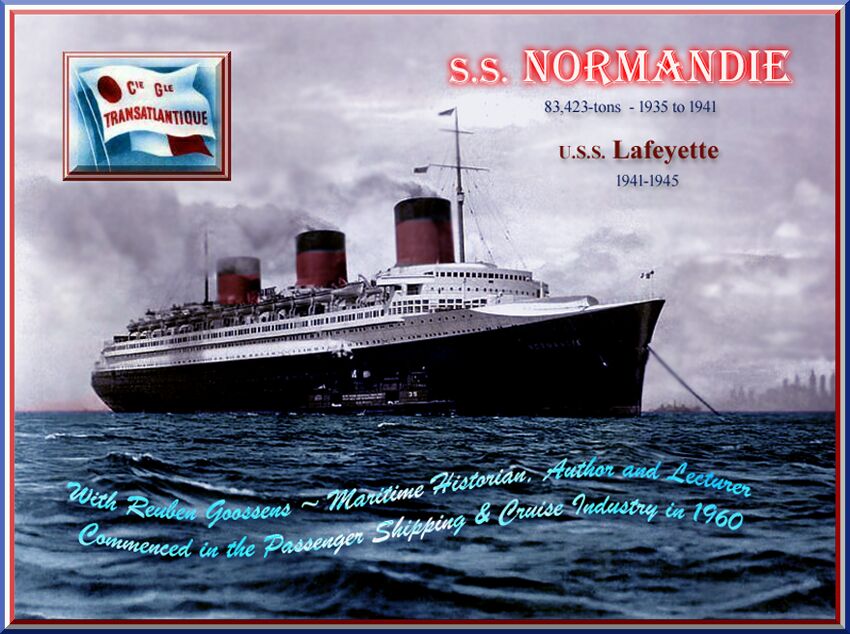
Please
Note: Postcards, photographs & other images
are either from the author’s private collection or from my supporters.
Thus a very thank you to three very special ssmaritime supporters for sending me their wonderful
photographs & images
#Gerrit de Weerd (NL), ^David Dougherty (US) and *Jean-Piere Crozier (FR).
I am sorry but some of the images shown may not be of the highest quality, but they are the best that were available
Part Two
Contains:
Second (Tourist) & Third Class Interiors,
1936 Refit, Her Brief Career, World War Two,
Her Tragic Demise, Specifications &
Details
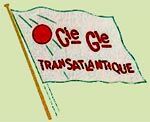
Please Note: If you have arrived here via a search engine, having searched for the “Normandie” then you may wish to first read Part One of this three page Feature. Click HERE or use the link at the bottom of the page. But if you have not read Part One, this page will not do her any justice at all!
A Brief Introduction to a Great, but sadly she was not a Successful Ship:
The S.S. Normandie was a
remarkable French Ocean Liner built for the French
Company, “Compagnie Générale Transatlantique” (CGT), but
better known worldwide as the “French Line”. She entered service in
1935 as the world’s largest and fastest passenger liner, and she
crossed the
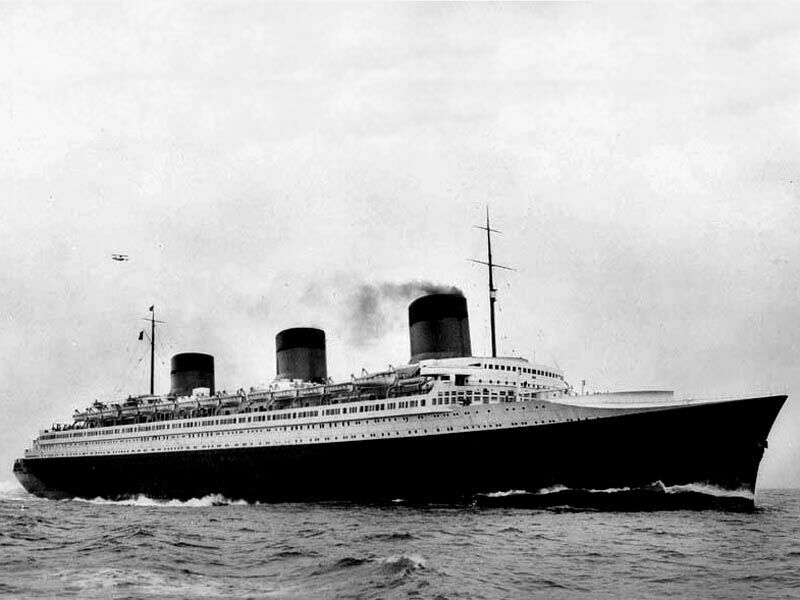
A great view
of the S.S. Normandie whilst sailing at full speed on the Atlantic to
I concluded Page One with an extensive section covering the interiors and exteriors of First Class (was later renamed Cabin Class) on board the “Normandie” thus now I will commence with the Second Class (was later renamed Tourist Class) and will follow it with Third Class. Many are surprised that both these classes were of such a high standard in fact Second class was in many ways superior to most first classes on other liners! Even Third Class was remarkably good, and what was so special about the “Normandie” was that every single cabin, right down to the very cheapest one in Third Class had a built in flat ceiling and not what all other ship had, an old style steel ceiling complete with bolts, etc.
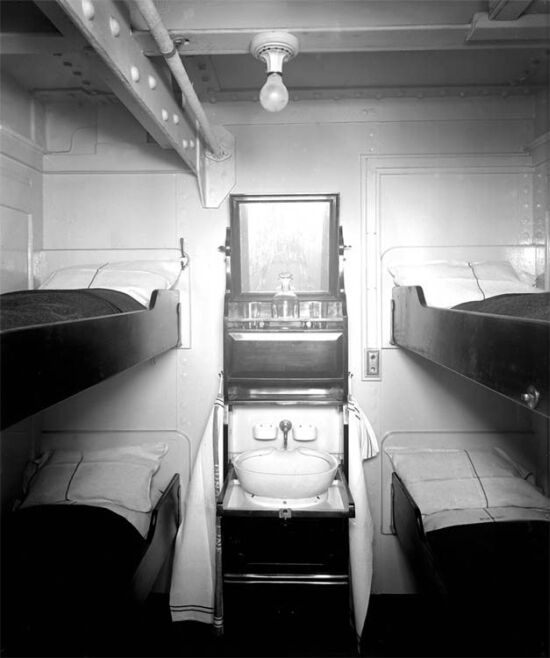
A Third Class four berth cabin on a Cunard liner with metal ceilings
In addition all mattresses on the “Normandie were not those traditional ship board thin mattresses, but rather very comfortable innerspring mattress, and that was from the ‘Grand Deluxe Suites’ to the cheapest Third Class four berth inside cabin!
********************
The sad fact was that S.S. Normandie’s First Class was so famous, and thus so well known; it soon became her biggest weaknesses. From Page One, we have become aware that Normandie’s design and layout was in reality mostly focused on serving her 848 Guests in First Class and thus French Line’s attention and the media paid little attention to her Second (Tourist) and Third Class facilities, which were in fact better than excellent. Thus regardless being credited for her over the top beauty and technological advance by all those who knew about her, the truth is so many people would go have a look at the “mighty” ship whenever she was in port, but when it came travelling they would choose to sail on another ship, including her biggest rival the R.M.S. Queen Mary. Sadly all the hype in the media and other sources was always in the manner as follows: “Normandie has without a doubt the most sublime interiors and her guests receive services as if they are all royalty”.
And for that reason she would sail generally
with passengers in First (Cabin) Class, whilst the 670 berths in Second
(Tourist) Class and the 454 berths Third Class were poorly occupied. In
February 1938, and again in February 1939, she operated a cruise from
Superiority of Second and Third Class:
However what most people did not know; and this was due to the “French Line” favouring their First Class, is that “Normandie’s” Second as well as her Third Class were by far superior then on 99.9% of other ships. These two classes were magnificent, and Second Class was more like First Class on all other ships, for the “Normandie” did have fine lounges and facilities in both of these classes. In addition, even the cheapest Third Class cabin had a fitted flat ceiling, rather than all other ships, Third Class cabins have metal ceilings with bolts in them.
Below are the facts of how great these two classes were, many who did sail on her actually preferred Second Class, for it was as one past passengers wrote;
“We sailed on the Normandie from
Thus the truth regarding this magnificent French Liner is that her greatest triumph’s also turned out to be one of her greatest flaws, and that was her decor. S.S. Normandie’s very bust and over the top First Class interiors proved to be very intimidating and uncomfortable for many of her passengers, and just like the professor who wrote me above, they disliked it and many booked their voyages on the R.M.S. Queen Mary. But in fact the Normandie’s Second (Tourist) and Third Class was really very good indeed!
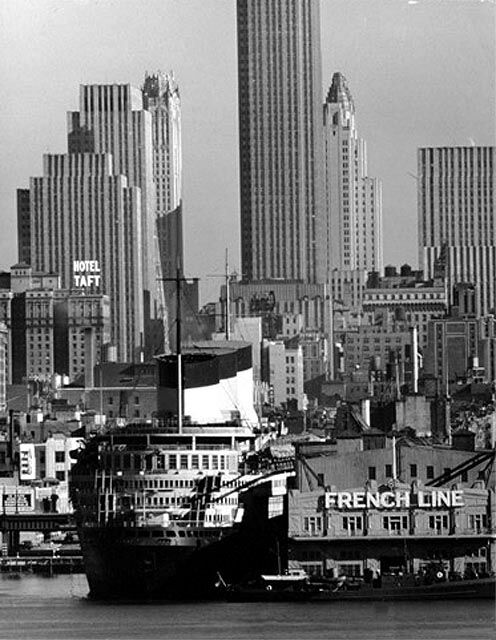
^ - A stern view of the “Normandie” berthed at
as we can see the new structure on
Sun Deck aft being the Tourist Class “Grand Salon and the “Café
Terrace”
********************
Second (Tourist) Class:
Please Note:
During her 1936/37 refit First Class became “Cabin Class” and
Second Class became “Tourist Class”.
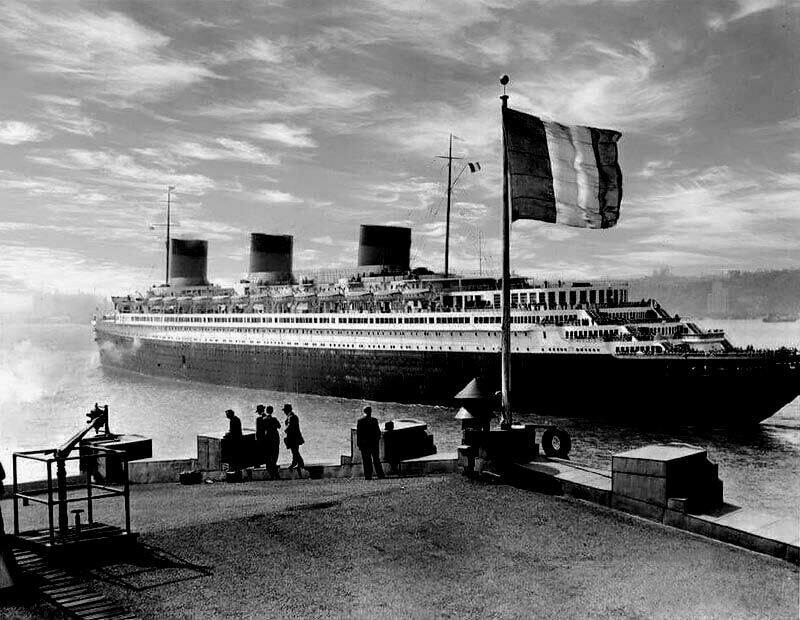
# - Here we see the S.S. Normandie depart
new Tourist Class Lounge extension
can be seen aft on her Boat deck
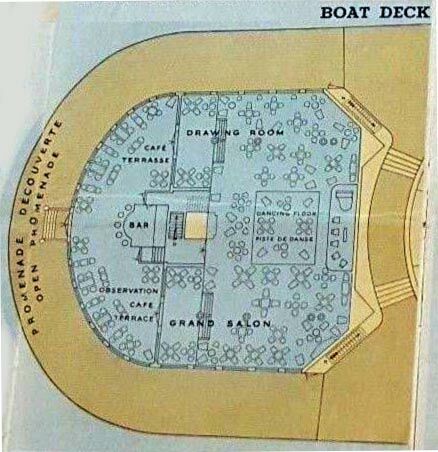
A plan of the new structure built aft on Boat deck, which increased her Tonnage to 83,423 GRT
The Grand Salon:
During “Normandie’s” winter 1936/37 refit, a new structure was constructed aft on Boat Deck aft, and it certainly became a grand venue, the newly renamed “Grand Salon”. Behind the band stand on the aft wall was a huge painting and of course a large dance floor. Whilst aft there were steps on both sides of the room that took guests up to a raised level and on both sides of this level there were double glass doors into the also new “Café Terrace”.
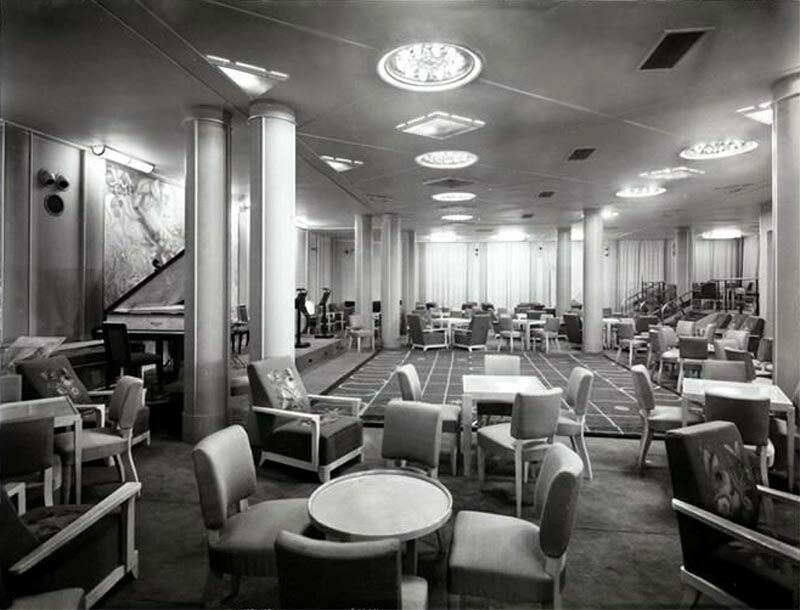
The “Grand Salon” certainly revealed that his new venue was very much a part of the “Normandie”
For note, the
floral upholstery on the lounge chairs can be found throughout the ship!
Café Terrace:
This new and delightful venue was encircled by floor to ceiling windows and was more like an observation venue as it provided a vast view over the stern of the ship. The aft walls were clad in a fine dark timber that went around the top of the rounded Bar in the middle of the aft wall.
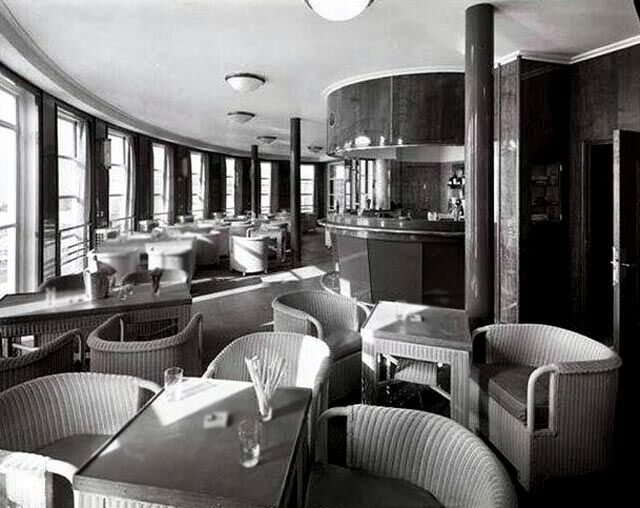
A delightful venue to say the least
The venue was furnished with all cane style
chairs, providing a casual atmosphere, with square and oblong tables also
featuring cane lower sections.
Smoking Room:
Located far aft on Promenade Deck was the delightful Tourist Class Smoking Room, and on the forward center curved wall the bottom had walnut timber, but it was topped by a decorative glass panel that stretched along the entire wall.
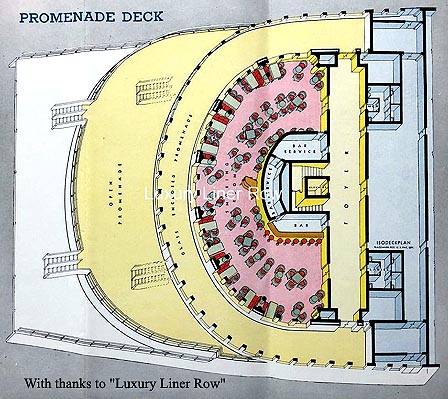
The Smoking Room featured large windows that curved around the entire venue from port to starboard providing a stunning view to both sides and aft.
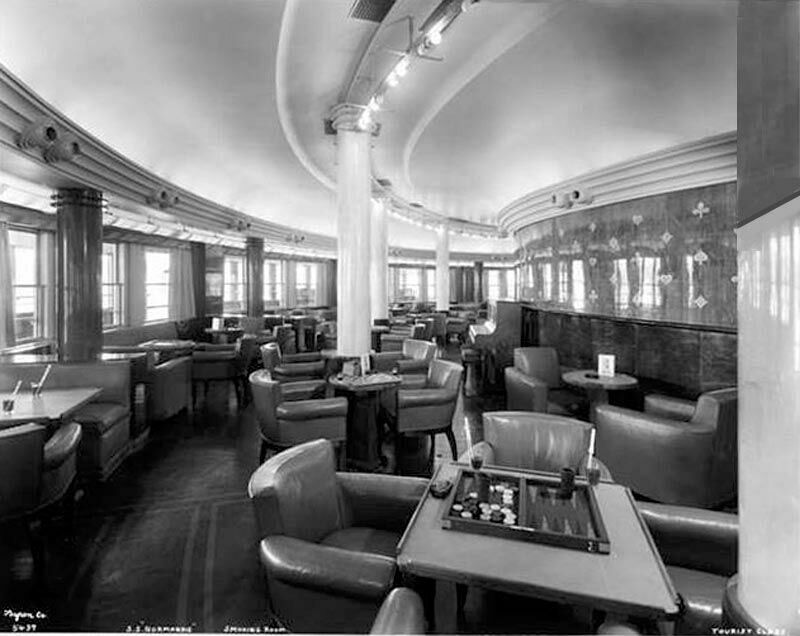
The Smoking Room
The Smoking Room with a Bar located on the starboard side near the aft, and the venue was furnished with luxurious deep and comfortable leather lounge chairs with both square and round tables that were perfect for a drink, with the square ones also good for playing a game of cards, or even a board game. Outside was a glass enclosed deck that went from the exit doors on both side of the aft hallway, and went all around the Smoking Room and provided a great view over the aft decks and the ships wake, etc.
Main Deck:
The Main Lounge:
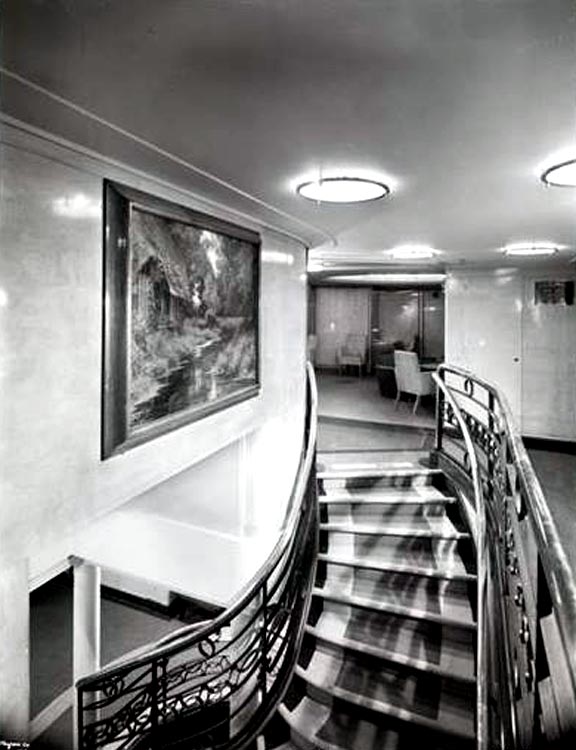
Aft of the Lounge is the double curved stairwell going down
The Spacious Main Lounge was domed in the centre went up into the Promenade Deck this venue was an attractive venue, being beautifully furnished, with a band stand and a dance floor.
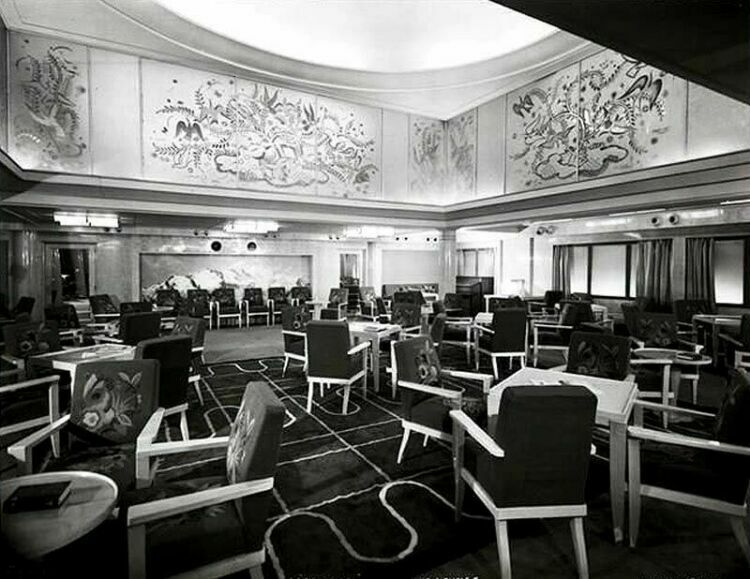
Aft of the Lounge were two venues on the starboard side was the Card Room, whilst on the portside the writing and reading room
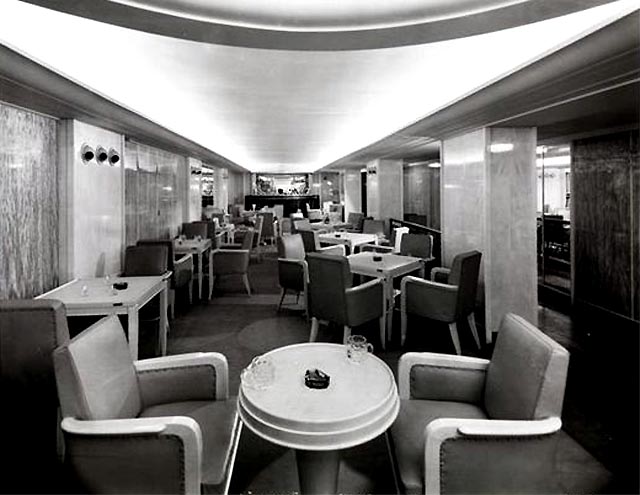
A very pleasant Card and Games Room
Aft on Main Deck was a huge glass enclosed Promenade deck again overlooking the stern of the ship and was used for many activities. It included a aft center structure which contained the Children’s Playroom on the portside and the Gym on the starboard side.
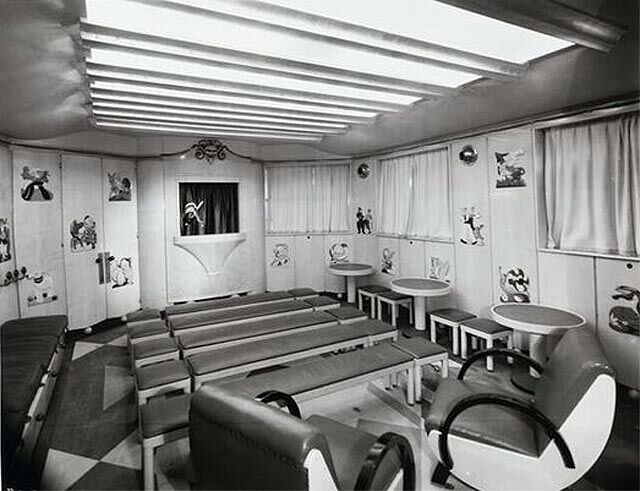
The
Children’s Playroom
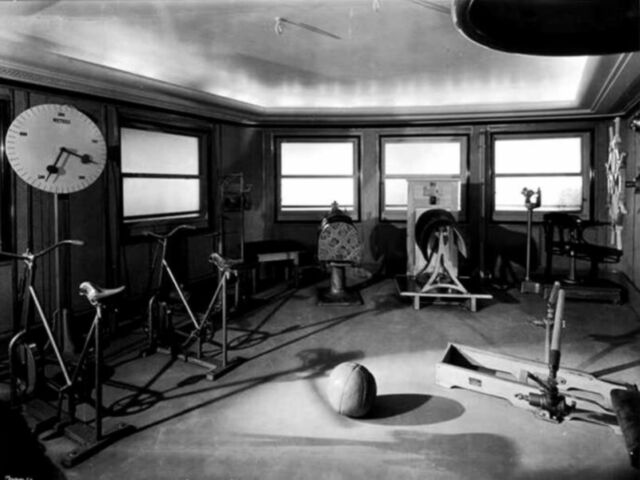
The Gym
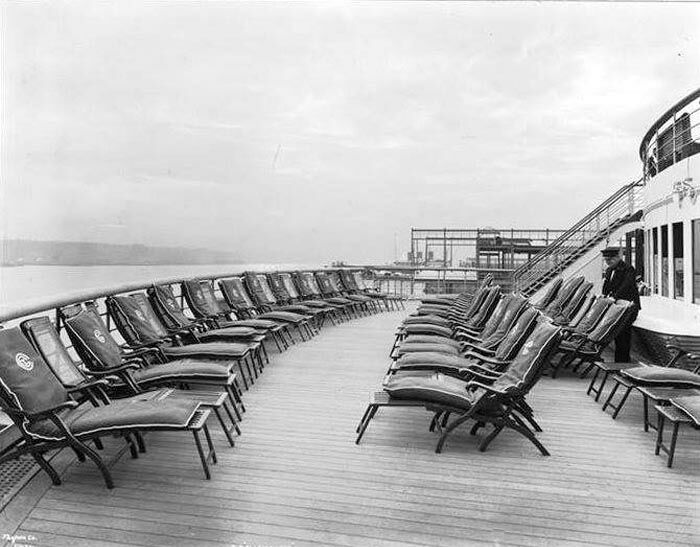
Main Decks aft deck with ample sun lounges
Directly aft of the glass enclosed promenade was an open deck as well as the Second (Tourist) Class swimming Pool.
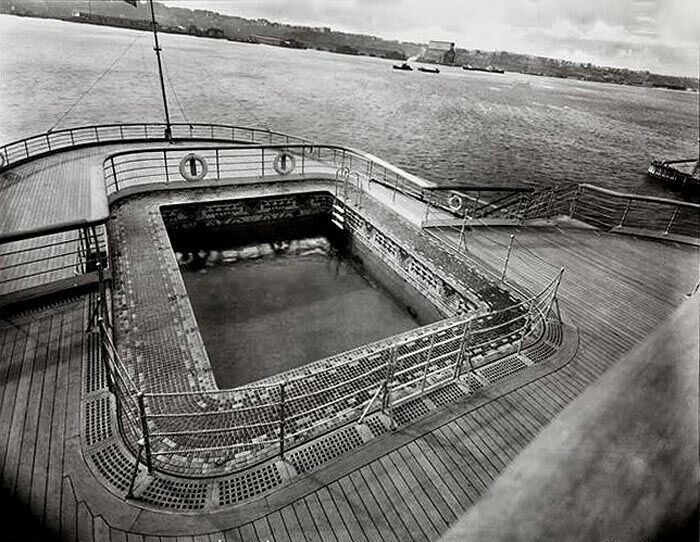
Here we see the
overhanging pool with the Third Class deck located just one deck down
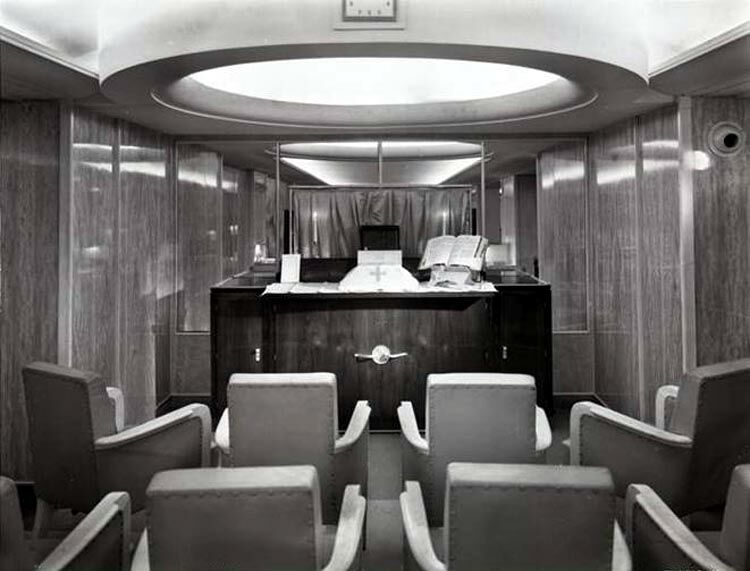
Of course, there was also a Chapel in Tourist Class
A and B Decks:
These decks as well as the lower decks offered a wide range of Second (Tourist) Class accommodations, the higher graded ones would be beautifully timbered, and others more plain, On offer were singles, two or three berth cabins, as well some four berth cabins many having Private facilities with either a bath or a shower.
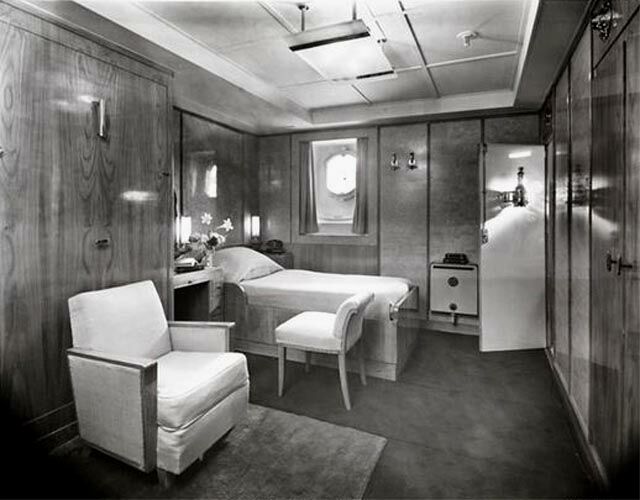
This is a Stateroom being an outside single bed room with a private bathroom
This style of
room was also available in a twin bedded configuration
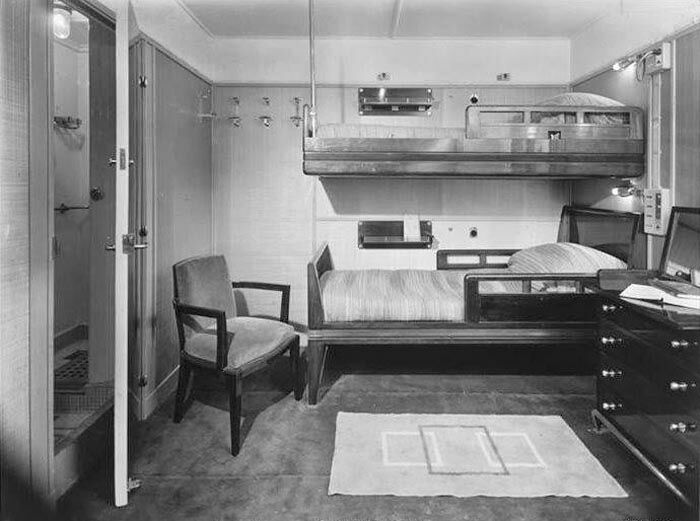
A typical outside
two berth cabin with private facilities
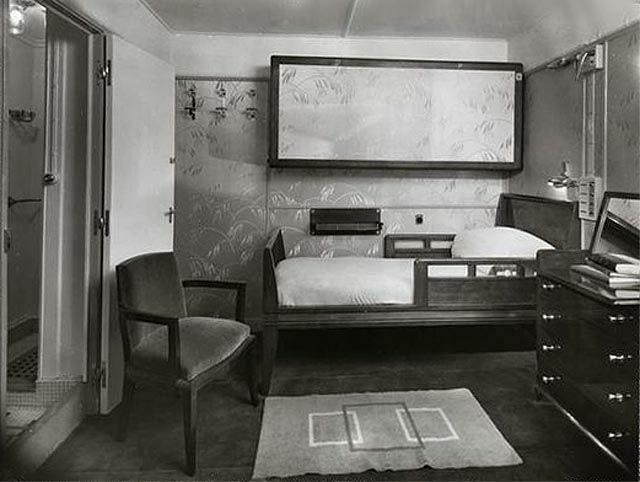
This cabin
can be used as a single or as a two berth cabin; it has private facilities with
a shower
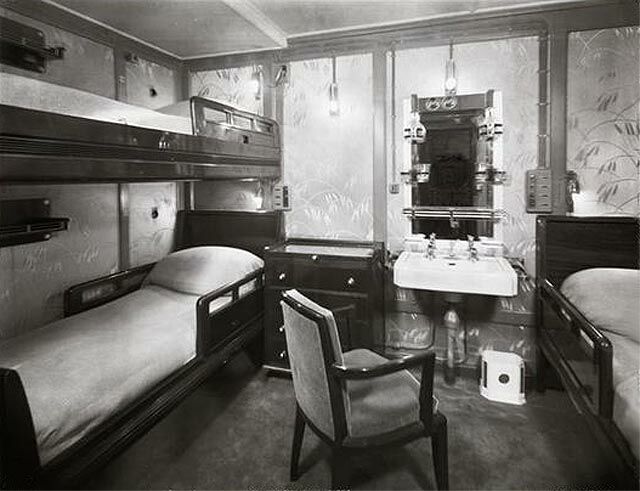
This is an
outside three berth cabin
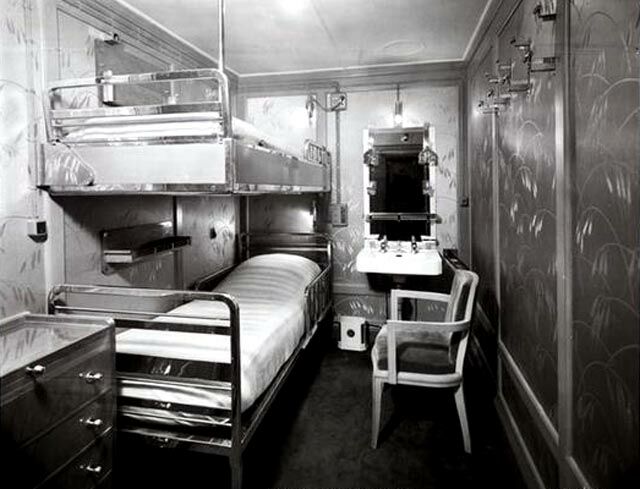
Located aft of the First Class Dining Room is the Second (Tourist) Class Dining Room, which was certainly a stunning venue as can be seen on the photograph below.
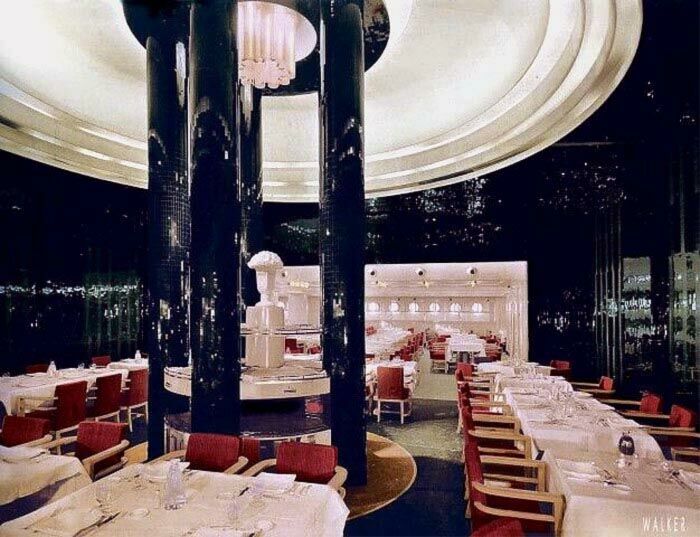
********************
Third Class:
On many ships Third Class was, to say the least, rather pathetic and the facilities were scant and the public venues generally looked like more of an afterthought. But not on the “Normandie, for this class was really quite remarkable. The sad truth is had the French Line publicised both Second (Tourist) and Third Class in a far more positive manner, they would have been fully booked at all times, for their public venues, Dining Rooms and accommodations were quite outstanding and made a shame of all other Trans-Atlantic liners operating in those days!
A Deck:
The well-furnished Smoking Room and the Bar was located here, and the room was fully carpeted, and its furnishings was of the finest quality leather lounge chairs and had square tables, which like the columns in the room were made or covered in a beautiful dark timber.
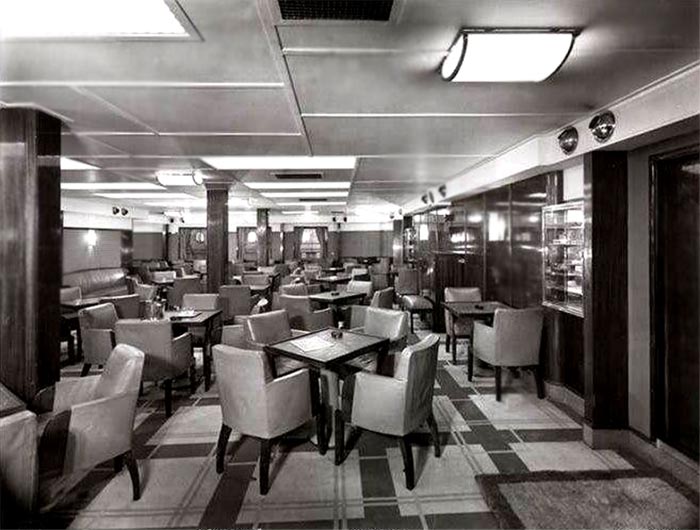
Above
& below: Two views of the delightful Smoking
Room
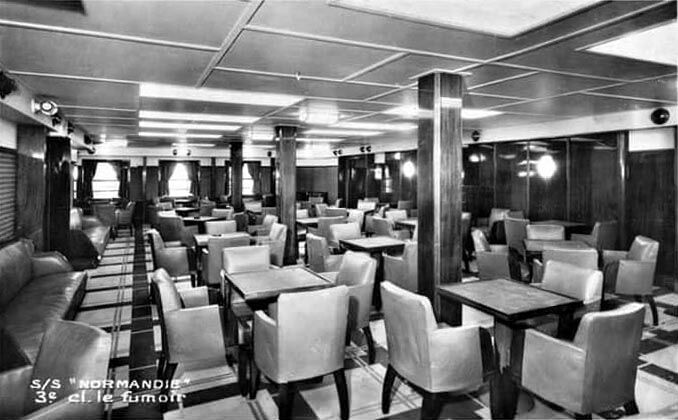
Just aft of the Smoking Room was the Third Class Hallway and stairwell, and just forward of that was the Bar.
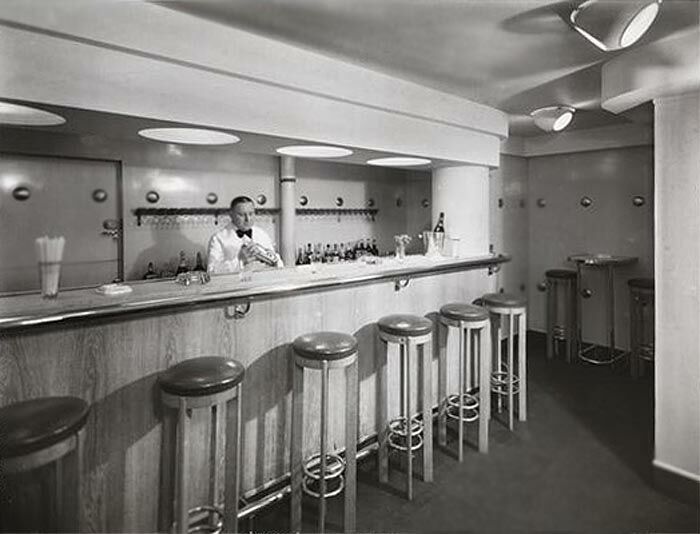
The Bar,
obviously a popular location, considering the ban on alcohol in the
B Deck:
Like the Smoking Room, this room was also located aft and again had leather lounge chairs with had metal legs and were of a more contemporary design, as did the round timber tables, that had a thick single or others with two metal posts.
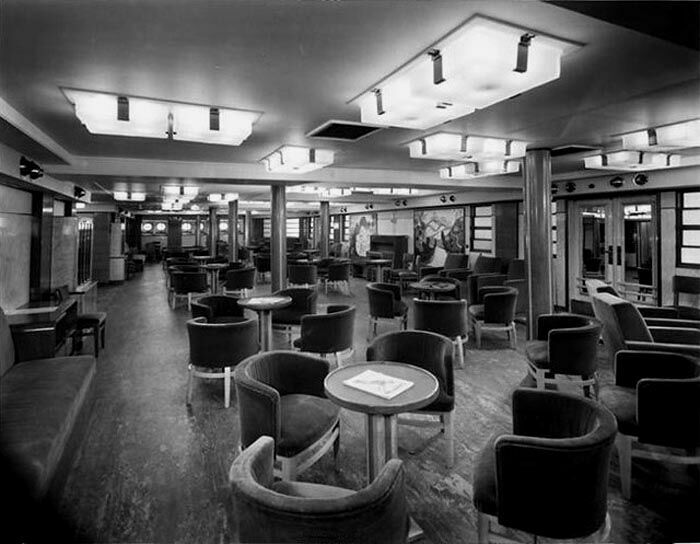
The Main Lounge was also the entertainment venue
E Deck:
The Third Class Dining Room comes as a surprise, for it looks more like a First Class venue on the majority of liners, for it is really very luxurious. Its walls were decorated in Marble and a large dome goes right up into D Deck, with the dome being staggered as it reaches a beautiful large decorative luminous feature light fitting.
There is no doubt this wonderful Dining Room is completely unlike any other Third Class Dining Room at sea, most have a fitted steel post topped with a swivel seat, but here everyone has their own freestanding high quality beautifully upholstered timber armchair. Tables are available from four to six, which is another first as other dining rooms in this class tend to have very long tables.
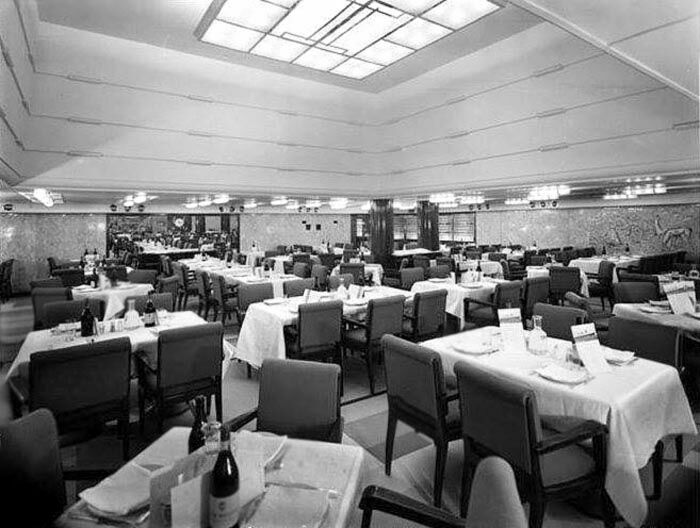
Yes, this is the Third Class Dining Room, which was certainly a first at the time
Accommodations:
I will now cover a number of the cabins that were available, and Third Class cabins were well above the standard of all other third class cabins on the ships that sailed in competition with the “Normandie”. For all cabins on board the Normandie” had fully panelled ceilings, which was not available on other ships, even in Second Classes there would be painted steel ceilings. The photograph below is of a cabin from a Cunard liner.

This is a Third Class four berth cabin on a very famous Cunard liner and note it has a hideous metal ceiling
In addition, what makes these cabins so special are the mattresses, which were all of such a high standard, and they were the same as those in first class, for comfort was the French Lines number one priority! All had a hot and cold washbasin and ample storage space.
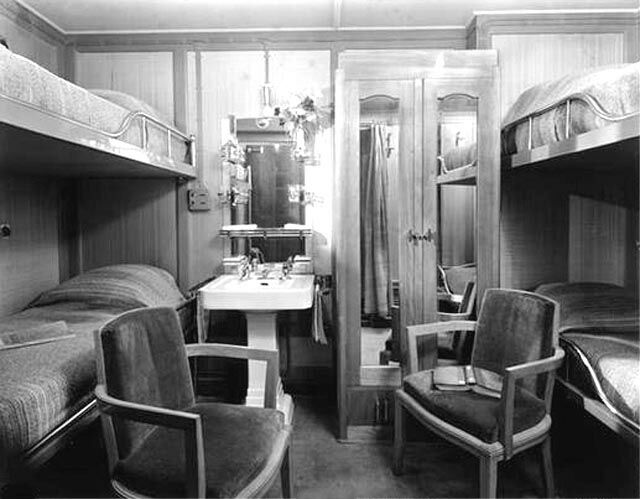
This was one
of the higher grades of an outside four berth cabins
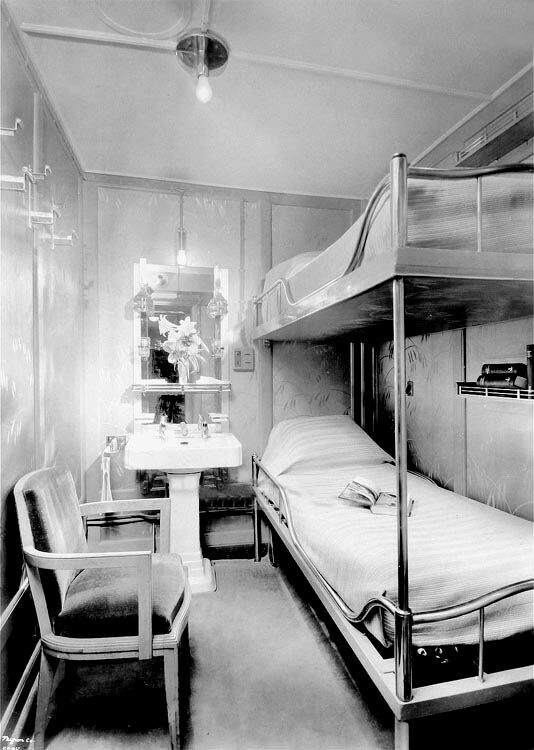
Two berth cabin #1022
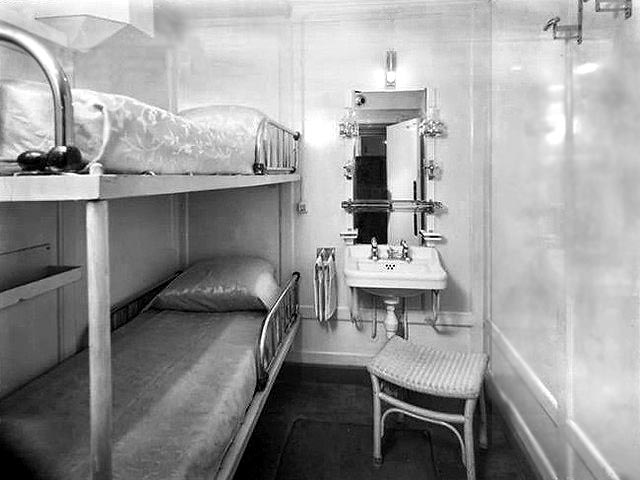
An inside two
berth cabin
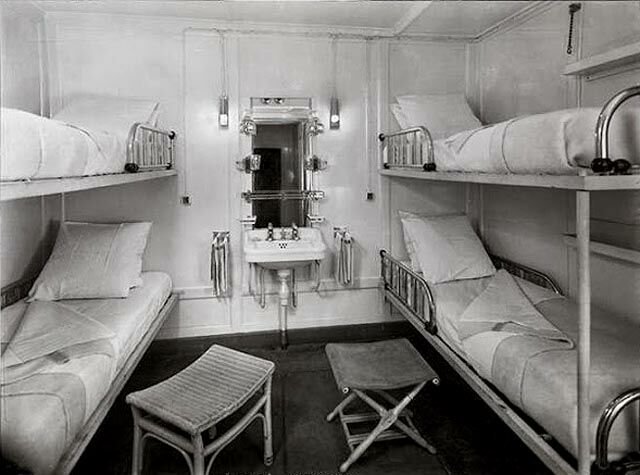
Here is another inside four berth cabin
********************
Remembering her maiden Voyage:
Although S.S. Normandie departed
“Normandie” refitted in 1936:
During the winter of 1936-1937 the “Normandie” was taken back to her builder’s shipyard as the “French Line” had already decided directly after her maiden voyage that urgent work was required. Her three-bladed screws were replaced with four-bladed screws as this represented the latest in technical standard.
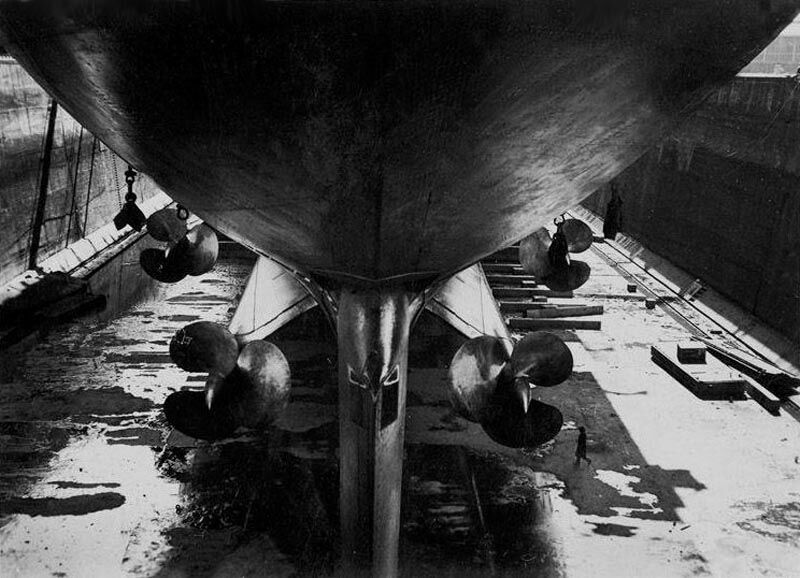
* - Above & below: The “Normandie” is seen in dry dock to have her 3 bladed screws changed
for four bladed ones, and the ship sitting in the dock, and that bulbous bow is a delight to see!
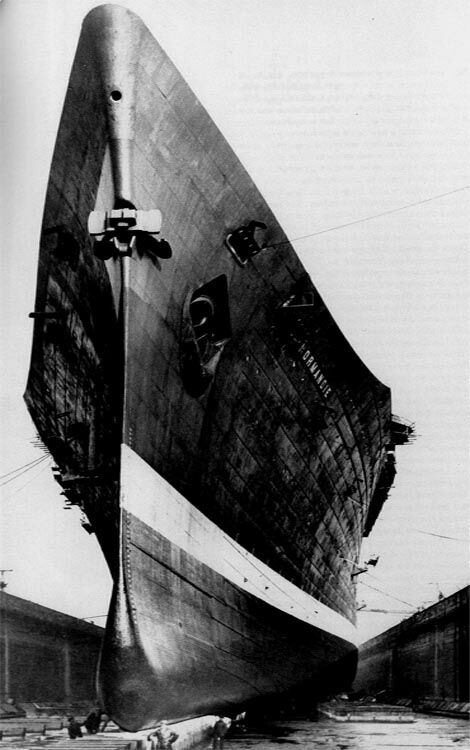
However, one of the major reasons for the work was to address the big problem of the vibrations that was experienced on board, especially by those Tourist Class passengers, although the effected cabins were no longer used. Thus structural modifications were also made to her lower aft section to reduce the occurrence of vibration. These modifications successfully reduced her vibration problem whilst she was sailing at speed.
In addition to all this, in the meantime larger boilers had been built and they were installed in order to increase her output from 165,000 HP to a superior 180,000 HP.
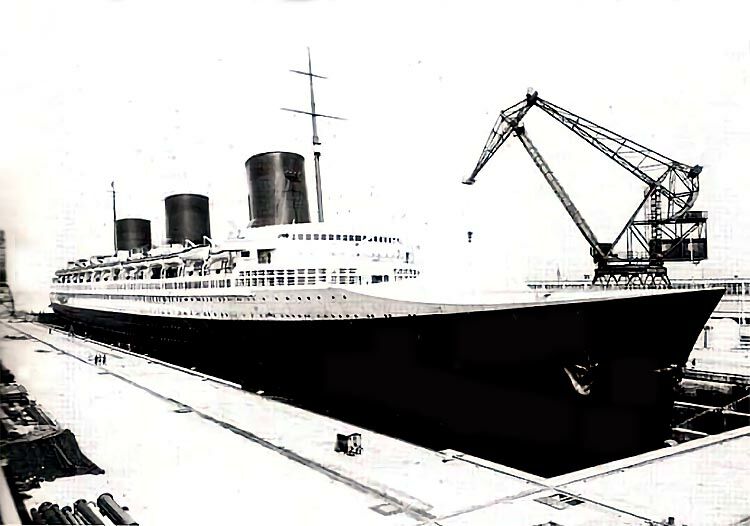
* - “Normandie” is seen in dry dock for her new 4 bladed screws to be fitted and her refit
In addition they decided to increase the ship’s size, which was done through the addition of a new enclosed Tourist Class Lounge and a Café Terrace aft on Boat Deck. Having completed the alterations well as other changes, the “Normandie” was re-measured and she was now officially 83,423 GRT, and thus she now exceeded the R.M.S. Queen Mary by a good 2,000 GRT and she would remain the world’s largest liner in terms of her Gross Registered Tonnage. With the “Normandie’s” speed increase it starting a fierce rivalry between the two ships, and in August 1936, the “Queen Mary” did capture the “Blue Riband” speed record sailing at 30.63 knots as we can see above, and then the Normandie regained it again in the next year. But all the “Blue Riband” details are shown above.
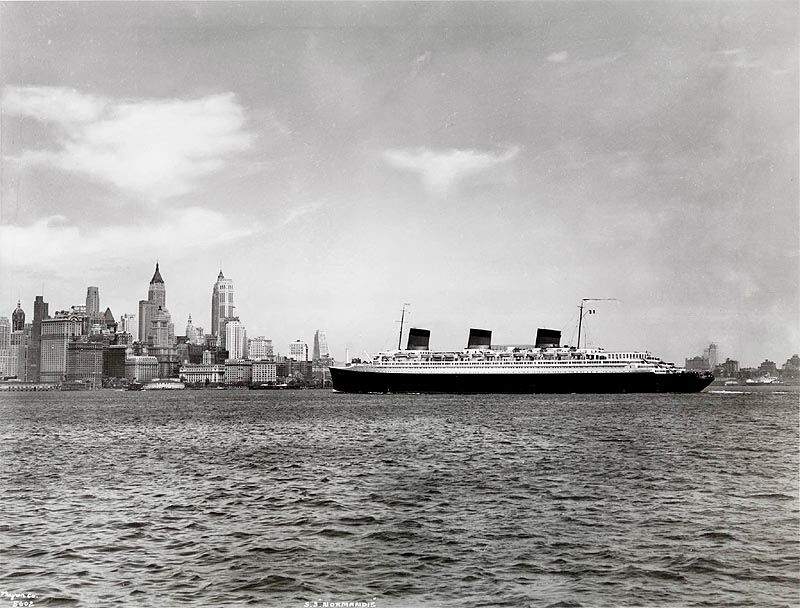
S.S.
Normandie arrives in
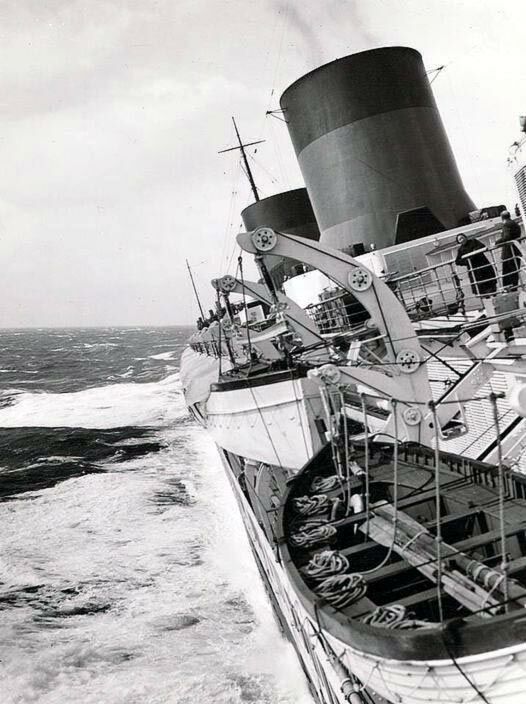
Although she was a big ship, she did hit some rough seas!
In July 1938, the “Normandie” made her one-hundredth Atlantic crossing. In those three years of service she covered 334,000 nautical miles which amounts to more that 15 times the circumference of the earth, at an average speed of 28.54 knots.
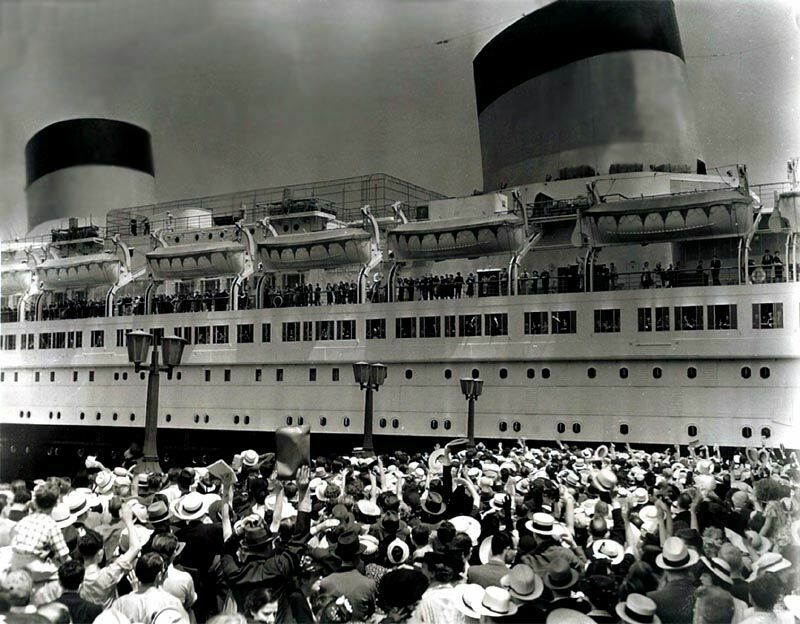
^ - The S.S. Normandie is seen ready to depart
The Rio
In 1938 the S.S. Normandie operated a 24 night
cruise to
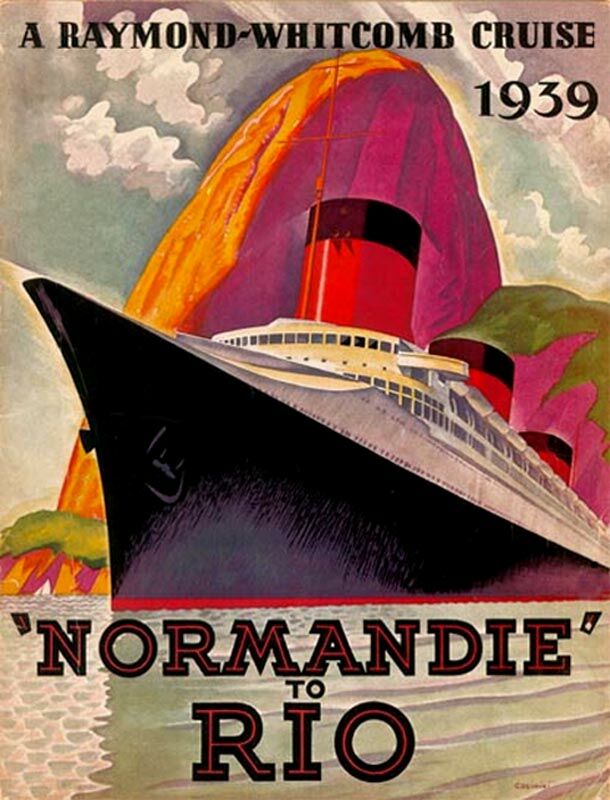
Above
& below: The
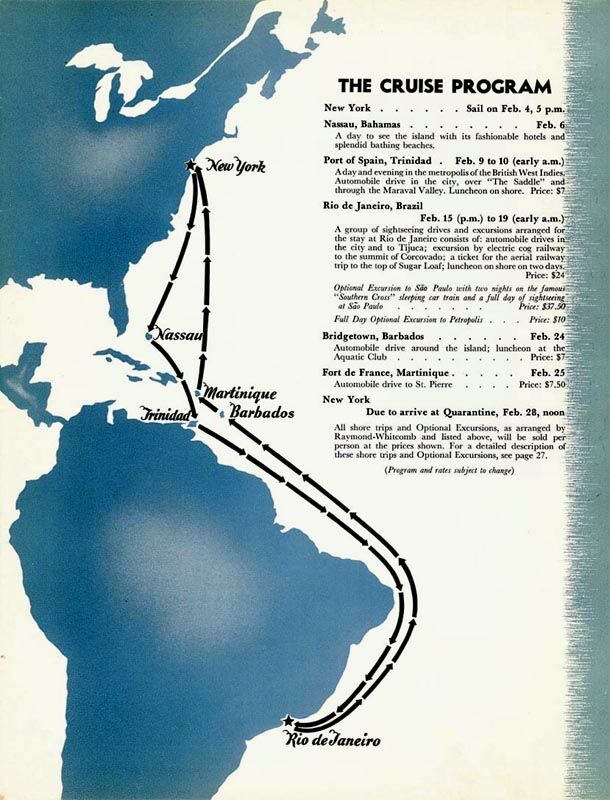
The second cruise departed
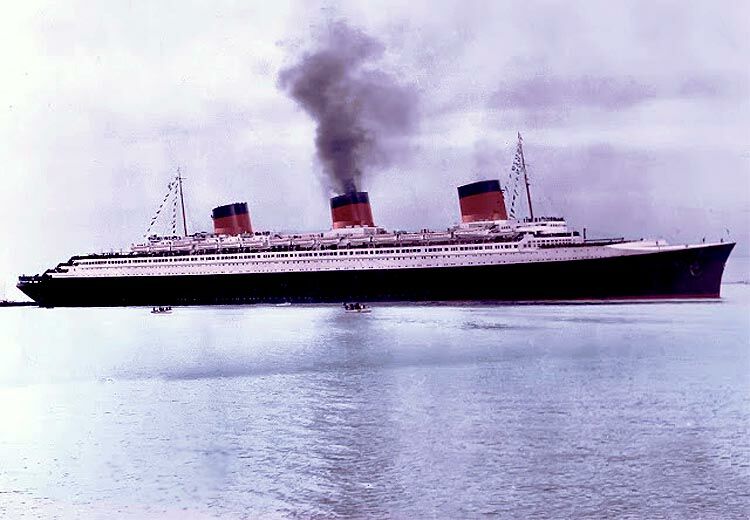
She is seen during her cruise
This cruise she accommodated 975 Guests in an all (One) First Class configuration.
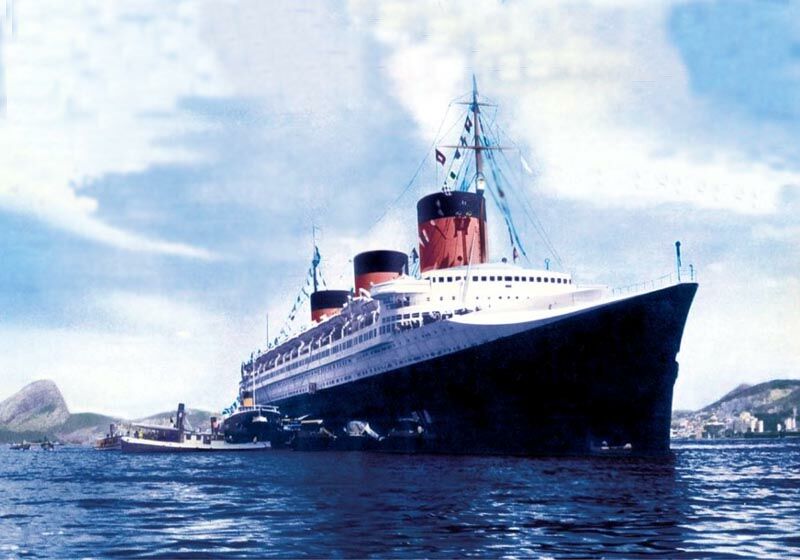
S.S.
Normandie is seen in port during her
Fares for this cruise was US$435 for a two berth cabin down on D Deck to US$8,600 for Suite DELUXE “Trouville” which offered nothing less than; a lounge, dining room, 2 outside 2 bedded bedrooms, 1 inside bedroom with 2 beds, an inside single bedroom, 2 baths, two showers, toilets, and a private terrace. These are rooms 5, 7 ,9 ,11 , 15 up on Sun Deck.
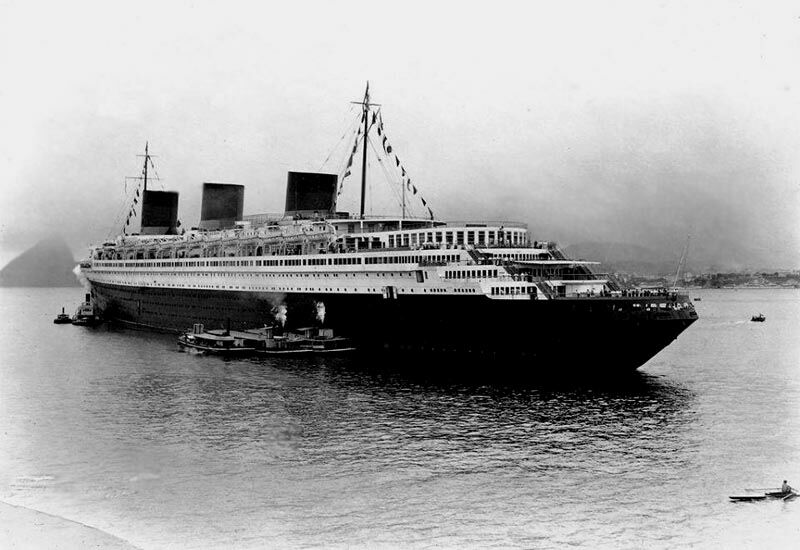
S.S.
Normandie is seen arriving at
After the cruise she returned to her regular
Trans-Atlantic duties until the time came in 1939 that war seemed to be on
horizon. Then came the day S.S. Normandie departed on her very last ever
departure from Le Havre on August 22, 1939 and she headed to
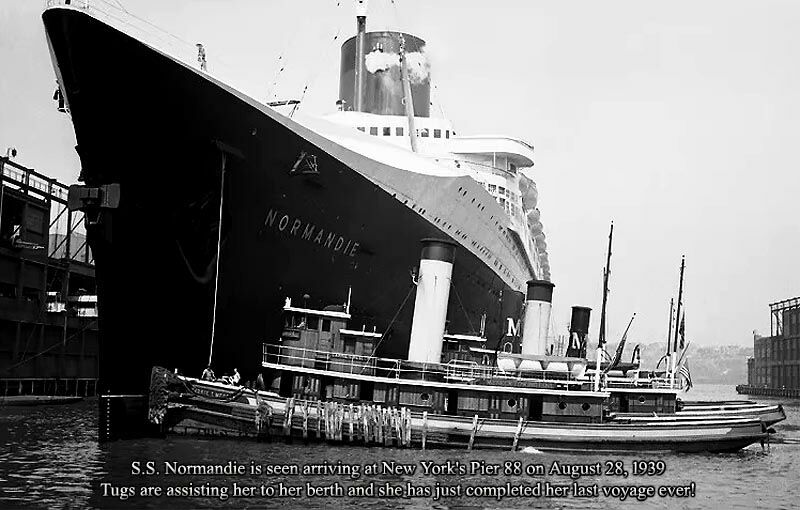
^ - S.S. Normandie is seen arriving at
This arrival meant the end for her Passenger Liner days, and only disaster lay ahead!
The end of “Normandie’s” Liner services:
It is so sad,
but “Normandie” sailed for just a very short 4½ years
before she arrived at New York’s Pier 88 on August 28, 1939 and after all
her guests had disembarked she was officially laid-up. Soon enough World War
Two commenced in
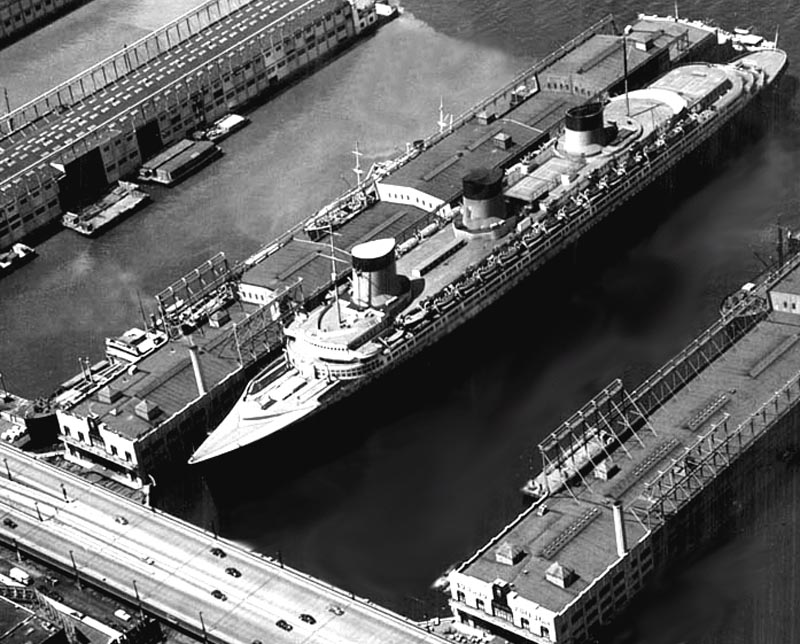
^ - Here we see a sad looking Normandie all laid up, with her funnel
covered up
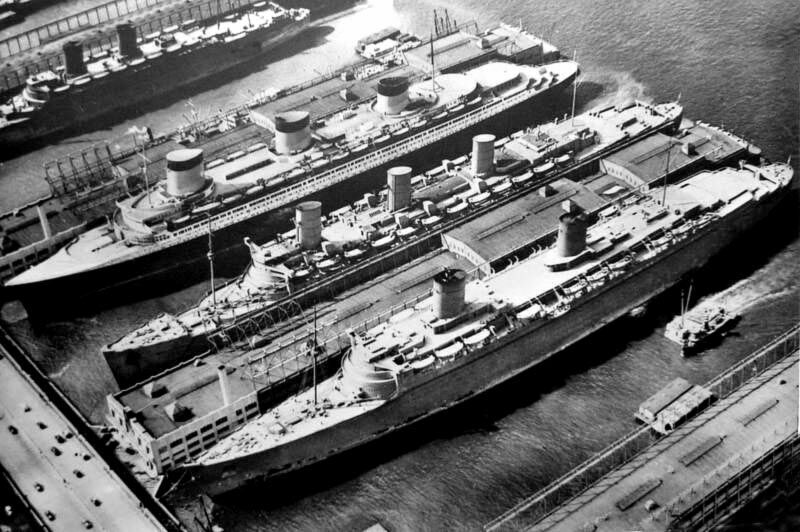
^ - Soon enough the “Normandie was joined by the “Queen Mary” and brand new “Queen Elizabeth”
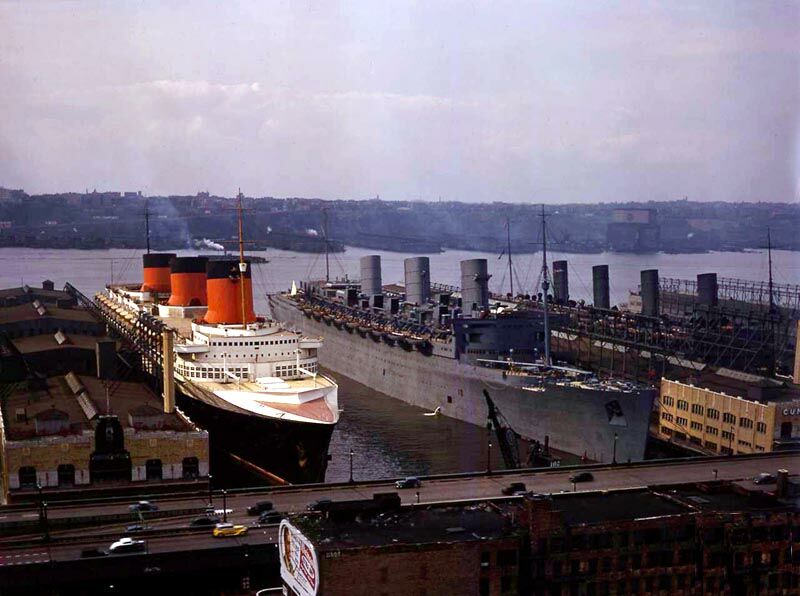
^ - An excellent photo of the “Normandie”, with the
“Queen Mary” still there, but she is joined by the “
World War Two:
On May 15, 1941 the unexpected occurred as
Sadly tensions between the French crew of the
S.S. Normandie, as well as those between
It is sadly well known from history, the
American’s are well known to be the last to come and help Europe
(therefore the British song “Over there, the yanks are coming”,
etc, well as per their usual self they did sweet nothing when they were needed,
and it was only after the Japanese attacked ‘
Sadly the entire world knows that a sad fact
of history, and that was that the attack on
After
However, to be completely honest, right from the start the American’s made an error, for obviously they are not really very educated, you see the correct spelling of the name should have been “La Fayette” not “Lafeyette”, this is because she was named after the “Marquis de La Fayette” who was a very famous French General, a politician and a member of the intellectual movement of the “Lumières”, his full name was; “Paul Yves Roch Gilbert Du Motier, Marquis de La Fayette”. Thus the ship should have been named correctly U.S.S. La Fayette (AP-53)!
The rapid seizure of the
“Normandie” was made as
With the Commission having taken control of the “Normandie” on December 22, we now know that she was transferred just two days later to the US Navy on December 24, 1941 with a plan to have her quickly converted into a troopship, as they were in desperate need of troopships. And tragically their emphasis was on the word ‘quickly’ which was a poor decision!
What was discovered next, that it was not going to be a major professional naval shipyard that would be converting her, no, this US$60 Million ships deserved a more or less an amateur bunch, because for some stupid if not an idiotic reason the Navy awarded the contract to a private small commercial company *“Robins Dry-Dock & Repair” (what Who is that?) and they were to undertake “Normandie’s” refit and turn her into a troopship.
For interest, if you Google “Robins Dry-Dock & Repair” you will discover that there are countless lawsuits against this company as there are pages and pages of actions against this company. Thus it is obvious they did not learn their lesson when their shoddy workers destroyed the magnificent S.S. Normandie, ala “La Fayette”.
In addition, the work was not going to be
carried out in a shipyard, no the big wigs of
The ship was quickly inspected and plans were drawn up for her to become a troopship. But there was a very big problem with the way the American official’s and their subordinates who refused to take any of the advice given by the senior very experienced French crew who knew the ship, as they say backward. The Americans were not only rude but to their detriment they stupidly decided that it was no need to check and read the company’s book on the ship and all her workings, etc, for they would have learned a great deal regarding the ships technology and regarding her very unique engines, which were far more complicated than anything the American’s had ever known. These Admirals and officers with their so called technicians behaved as if the ship’s crew were simpletons, sorry guys, it is you that fit the picture, because of your utter superiority, arrogance and stupidity, she was completely destroyed, and that is the truth of it! And the whole world knows it!
The world does know what the American’s did, for countless naval architects, maritime historians and war correspondents, as well as countless ship lovers believe that that the US Navy seem to treat the gift of this great ship which they really confiscated, was treated more as if they now had some cheap toy to work on, and for some reason they treated this magnificent new (US$60 million) ship with great disrespect.
Next everything was removed from the ship, fittings art works, 18,000 bottles of priceless wine, but one of their crimes was they destroyed the huge and magnificent “Grand Sale à Manger” being massive bronze doors which was a priceless creation, yet disgustingly the yanks just wrenched them down to fit the entrance for a church. Altogether 2,400 trucks were used in transporting all her costly interiors and it cost US$ 100,000 in transport costs, in addition several local warehouses had to be rented for their storage.
I need to remind you that the Admirals made
their first major mistake by not reading “Normandie’”
manuals, OK, so they had to be translated into English, surely for this
so-called great nation of
For what did these complete idiots do wrong you ask? Well, let’s start with the fully built-in firefighting system of the ship which was one of the best systems in the world, “Help”, it was mostly disabled, call it switched off. In addition they disconnected the electrical connection to all the fire doors throughout the ship, thus should they be needed they could not shut! If that was not stupid enough, “Help”, they had also switched off the water pumps. Who were the clever boys then, sorry I mean the world’s greatest Idiots? I am sure that by now you will have the picture, and why it annoys me so much as it still does to so many others who have written me, is that it seems they still have not learned!
The US Navy’s plans were so unbelievably naïve, for somehow these Admiral’s somehow believed that they could finish this massive renovation task within a month. But with so much work required to be done, and certainly not by a naval yard, but some nobody yard, it obviously delayed her completion from the end of January 1942 to the end of February.
It seemed that it was like utter madness on the ship for these mostly inexperienced non professional “Dry-Dock & Repair” workers rushed throughout the ship like madmen all because they had to meet a completion schedule. But of course the February deadline they thought could only be possible if all the vital safety regulations and all other official regulations were completely disregarded, and believe me it was!
There was a great deal of work done on her superstructure and her external regions. In addition they had also commenced to paint her in the traditional War-Livery of various shades of grey with green touches to her funnels.

Indeed, the U.S.S. Lafayette (Ap-53) began to
look like a troopship, and sadly any elegance of the magnificent “
Then on Monday February 9, 1942, these workers who did just did not care about this ship were working in a reckless manner. One team was in the former Grand Salon and they were to remove wood panelling as well as certain steel fixtures. To do this they used their welding torches. But these men must have been completely blind for so very close to the work they were doing was stacked hundreds of sacks filled countless kapok life jackets, and welding work was so close to it. To make matters worse, as was customary at the time, these life jackets were wrapped in oil-soaked paper. As we may know, *kapok is a highly flammable material.
*kapok, (Ceiba pentandra) is also known as Java cotton or Java kapok. It is “seed-hair fibre” that is obtained from the “kapok tree fruit’ or the ‘kapok tree’ itself and it is highly flammable!
Well these men with their welding torches obviously were short of being smart, and thus being completely incompetent soon enough sparks from their torches flew onto the Kapok life jackets at 02:37 pm and they caught fire and very rapidly this fire got completely out of control!
Those who were in charge on the bridge were unable to trigger the fire alarm, why, it was simply because no-one there knew their way around the bridge, well if you people had read “Normandie’s Manual you would have had no problem, but they though that they were all just too smart! Nobody knew where to turn off the heating or even the ventilation system. Did they not work for the so-called very (non) professional “Robins Dry-Dock & Repair” ship-yard.
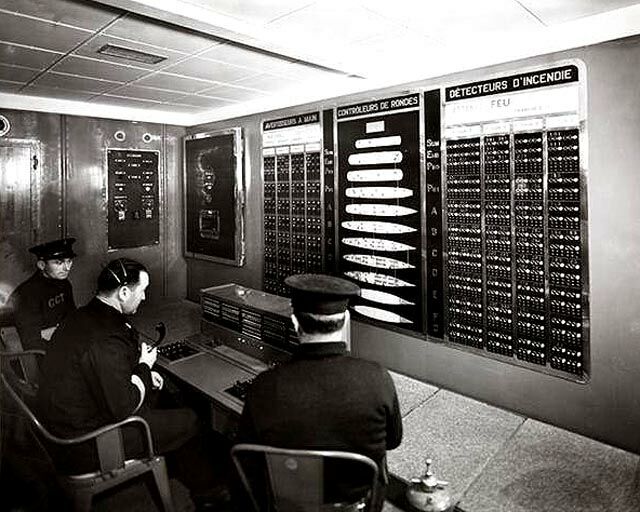
The Fire Detector Board
The “Normandie had an extremely efficient fire protection system, but of course the workers had disconnected it during the conversion and its internal water pumping system was also deactivated, thus due to their utter stupidity allowed the fire to spread rapidly.
In spite of the French experts attempting to advise them, and all the regulations they were told about, they simply refused to listen and just about everything that mattered had been switched off during the renovation process, and that is how clever these American’s were, to say the least they were an utter disgrace.
Although an assigned
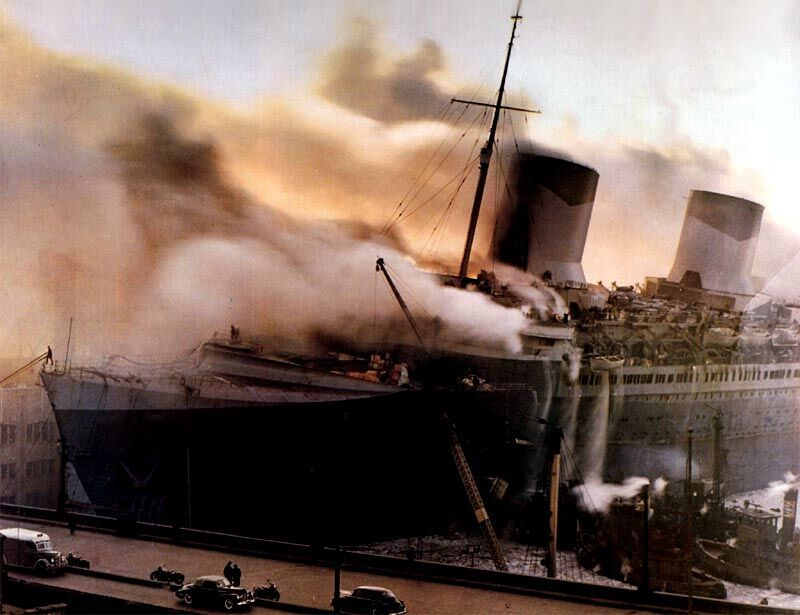
# - A very sad colour photograph of her ablaze
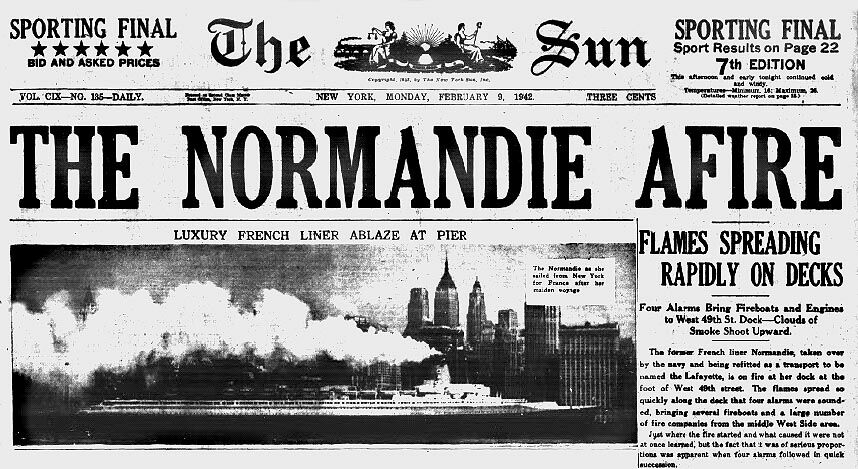
That night the papers carried the sad story of the fire
Water was pumped into the seaward side by fireboats in an effort to stop the fire, but this caused a dangerous list to port. By later in the afternoon, the fire was considered under control, but the list was gradually increasing.
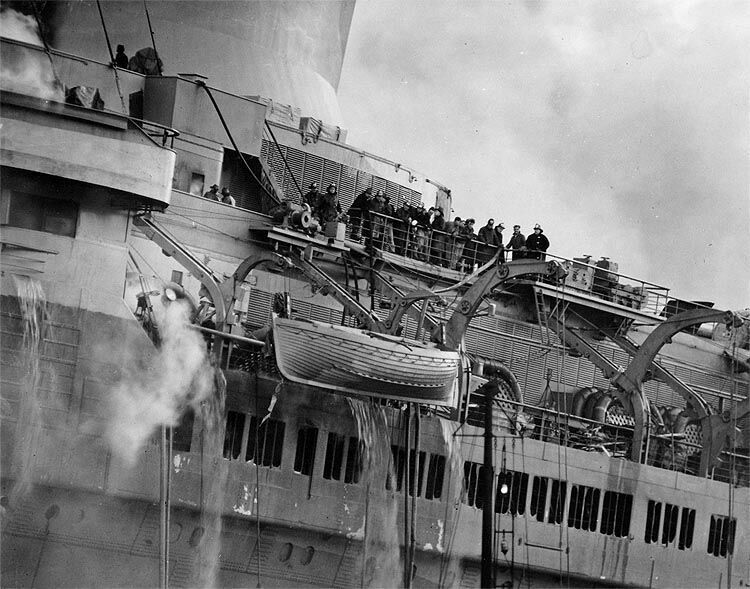
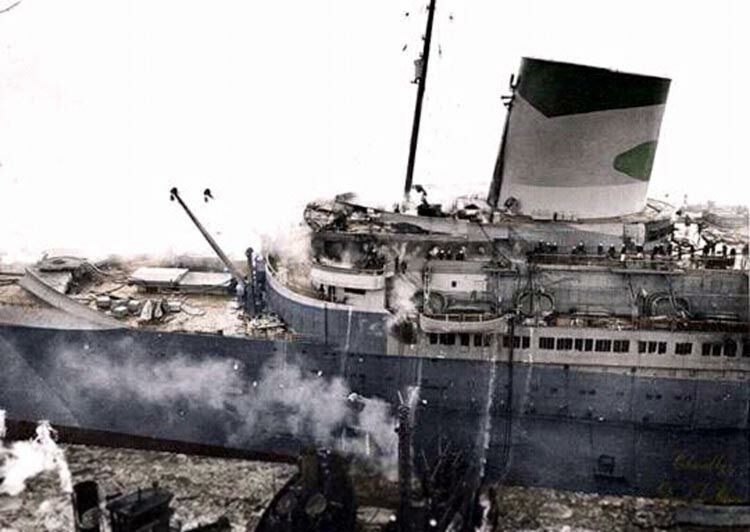
^ - Another shot of fire fighters at work, but we can see that she
already looked like an American troopship
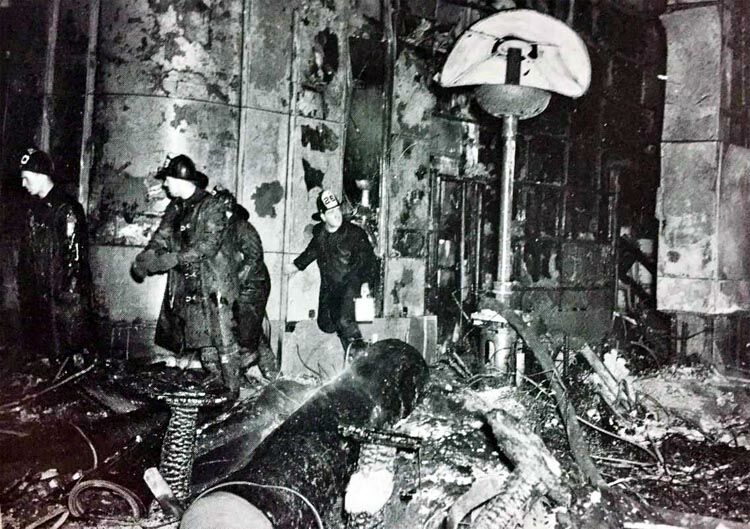
Firemen inspect the wreck after the fire on February 9
After the fire was under control, her list continued to increase, and then on Tuesday February 10, 1942 at 2:45am she capsized onto her portside. She remained there for almost the next 18 months.
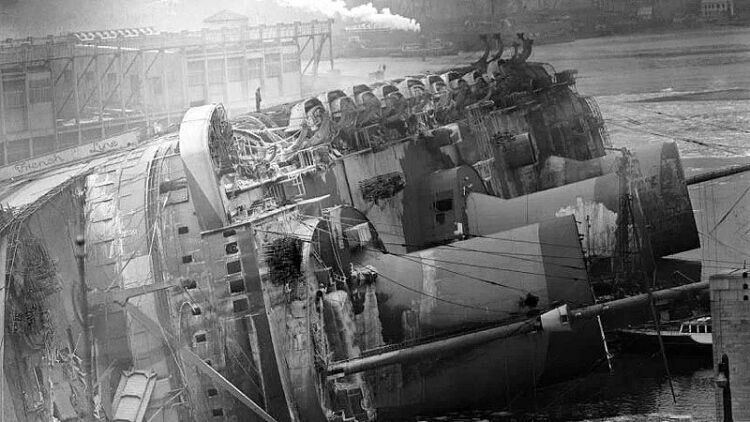
# - Above & Below: Three tragic views of what was the magnificent S.S. Normandie laying on her side
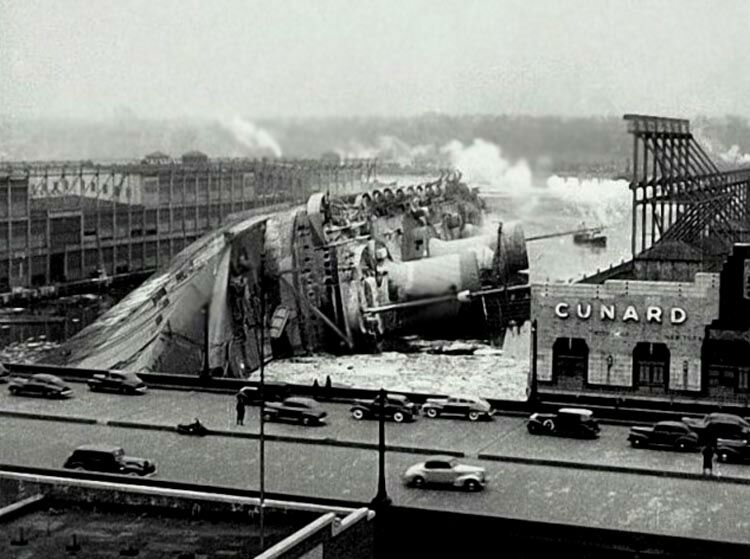
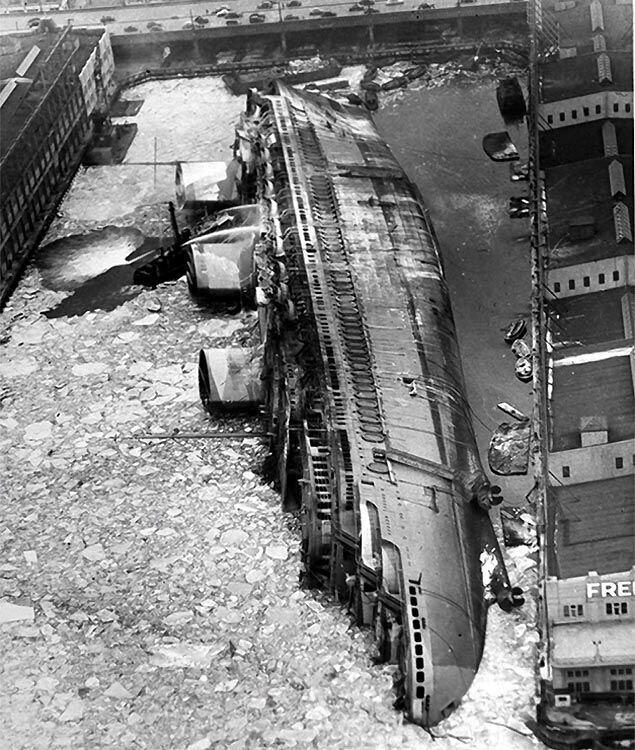
During 1943, she was stripped of her superstructure and it had been decided that she would be finally righted on August 7, 1943, and towed to a ship-yard.
Although enemy sabotage was generally suspected by the public, but a Congressional Investigation in the wake of her sinking, which was chaired by Representative Patrick Henry Drewry, it was concluded that the fire was accidental. But, the investigation did find evidence of “carelessness”, “rule violations”, a “lack of co-ordination between the various parties on board”, “A lack of clear command structure during the fire”, and a “hasty, an a poorly-planned conversion effort”. All this again proves that the American Navy its Admirals who refuse assistance from the French crew, that they were all part of a group of people who were to say the least an utter disgrace, and they were wholly responsible for the destruction of the world’s largest super luxury liner, all due to their complete carelessness, if not being complete incompetents to say the least!
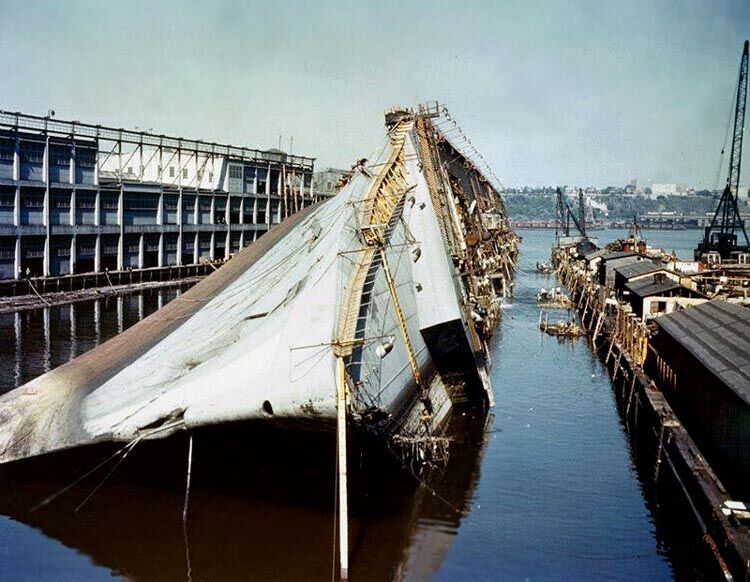
^ - During 1943 her superstructure was removed, to be made ready to be righted
Finally, on August 7, 1943 the remains of the S.S. Normandie / U.S.S. Lafayette was lifted at a massive cost of US$19 million and this was the most expensive salvage operation in history at that time. The US Navy believed that her solid hull was still useful and plans had now been made for her to become an Aircraft Carrier.

The “Lafayette” was reclassified as (APV-4) being an aircraft carrier on September 15, 1943, and on November 3, 1943 she was taken by ten tugs to dry-dock.
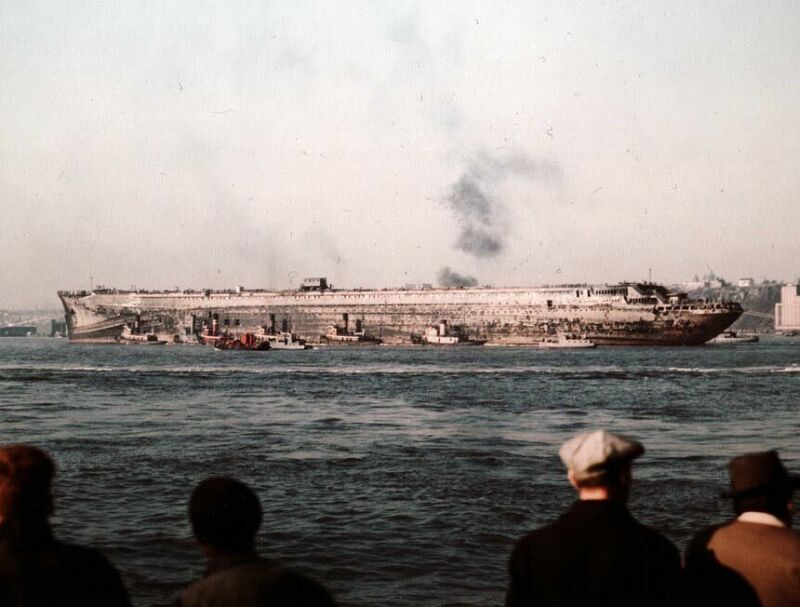
Ten tugs taking her to the Dry-dock on November 10
However, after an extensive inspection, it was decided that the damage to her hull, was far too great as well as severe deterioration to her machinery, and it would employ so much manpower on her, rather than work on other more critical war projects. Thus the cost of restoring her would simply be far too great. Her hull remained in the Navy’s custody until October 11, 1945.
The “Lafayette” was officially stricken from the “Naval Vessel Register” on October 11, 1945, thereafter President Harry Truman authorized her disposal in an Executive Order on September 8, 1946, and the remarkable ex S.S. Normandie was sold on October 3, 1946 to “Lipsett, Inc.”, being an American ship breaker based in New York City, for a mere US$161,680, who had their yards at Port Newark, New Jersey, being 21 klm away from New York by road.
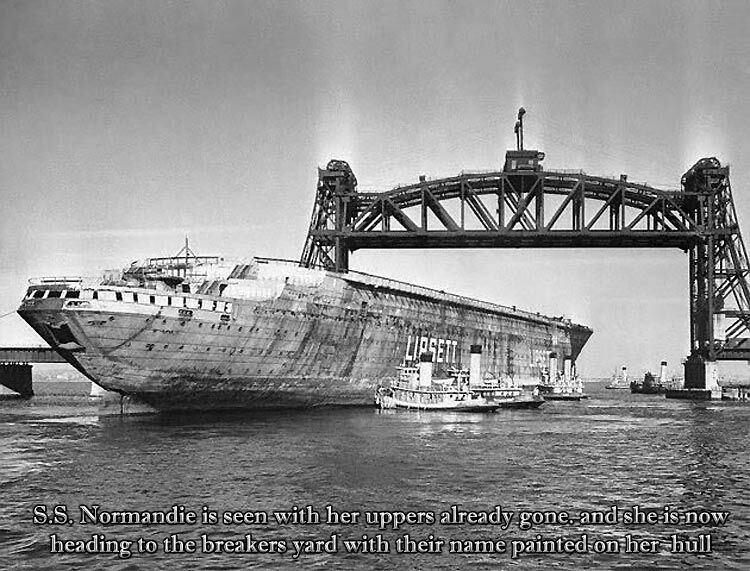
Her final voyage under tow to the breakers yard
That was because neither the US Navy nor
“French Line” (thanks
to
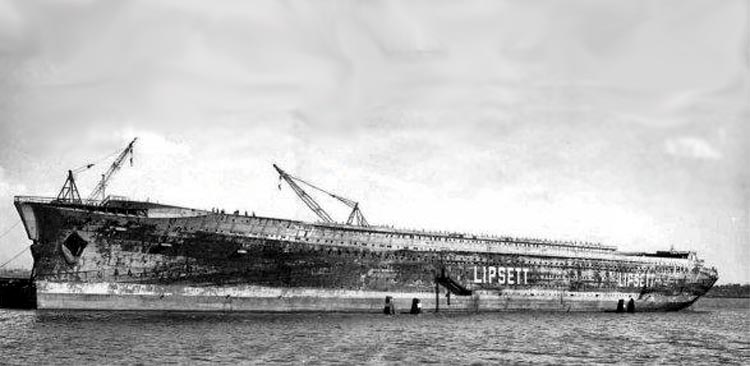
Her final destination is here at the ‘Lipsett’ yards
The breaking up of the once great S.S. Normandie commenced in October 1946 at Port Newark, New Jersey, and she was sadly completely gone by December 31, 1948.
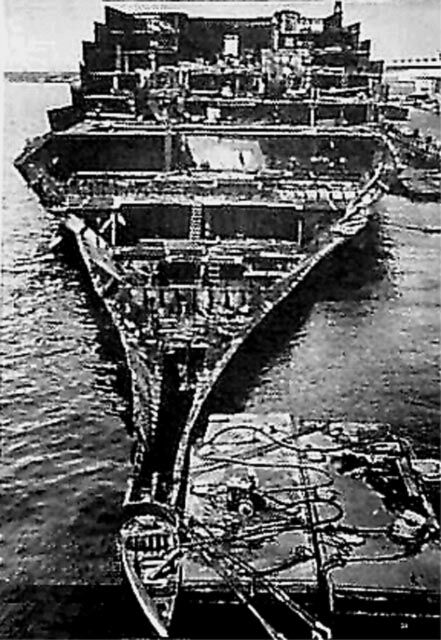
A premature
end for the ex “Normandie” is near
Postscript:
After the war much of the art from the S.S. Normandie was sold off, but amongst it was one great tragedy, and that were those magnificent creations 6 m - 20 ft high door at the Great Hall, being the entrance to the Great First Class Dining Room. The doors and Medallions were created by French artist Raymond Subes.
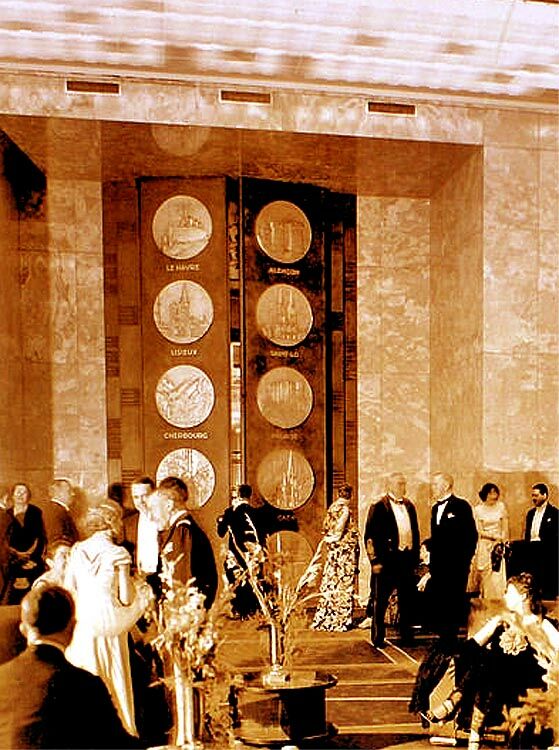
Tragically after the war these huge doors were
auctioned off and were obtained to become the doors of “Our Lady of
Lebanon Cathedral” in
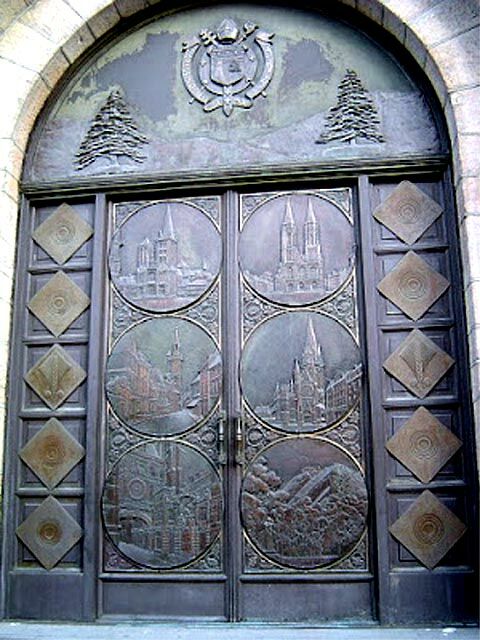
S.S. Normandie Specifications and Details:
Names: S.S. Normandie 1935-1941.
. U.S.S. Lafayette (AP-53) - 1941-1943.
. U.S.S. Lafayette (APV-4) - 1943-1945.
. S.S. Lafayette - 1946.
Type of ship: Passenger Liner.
. Naval Transport (AP-53) December 27, 1941.
. Refloated August 8, 1943 & towed to “Brooklyn Naval Shipyard”.
. Transport and Aircraft Ferry (APV-4) 15 September 15, 1943.
Owner: Compagnie Générale Transatlantique (the French Line).
.
. Lipsett Incorporated (ship breaker) October 3, 1946.
Operators: French Line - 1935 to 1941.
.
Call sign: PNSK.
Builder: Chantiers de
Penhoet”,
Laid Down: January 26, 1931 as “T-6”.
Launched: October 29, 1932.
Trials: May 5, 1935 -10 days of seas trials.
Delivered: May 19, 1935.
Maiden Voyage: May 29, 1935.
Tonnage: 79,280 GRT.
1937: 83,423 GRT.
Length: 313.6 m - 1,029 ft.
Beam: 35.9 m - 117.10 ft.
Draught: 11.2 m – 36.7 ft.
Installed power: Four turbo-electric transmission motors, with turbo-generators and electric propulsion motors, total 165,000 HP
1937: 180,000 HP (200,000 HP max).
Built
by:
Propellers: Quadruple, 3 bladed as built, but changed to 4 bladed in 1936.
Speed: 29.5 knots as built, 32.2 knots maximum during her sea trials.
Accommodations: Total: 1,972: 848 First Class (Cabin), 670 Tourist Class, 454 Third Class.
Crew: 1,345.
Decks: 12.
Cargo: 46,280 cubic feet (1,311 m3) refrigerated space.
Her Final Days:
Renamed: Lafayette and designated Naval Transport (AP-53).
February 9, 1942: Severely damaged from fire
on February 9, 1942 at
February 10, 1942: She capsized to port.
Refloated: August 8, 1943 & towed to the Brooklyn Naval Shipyard.
September 15, 1943: Was redesignated Transport and Aircraft Ferry (APV-4).
October 11, 1945: She was struck from the Naval Register and transferred to the Maritime Commission for disposal.
October 3, 1946: Sold to Lipsett
Incorporated (Ship breakers) and her hull was soon
broken up.
*********************
Remembering the Great …
S.S. Normandie
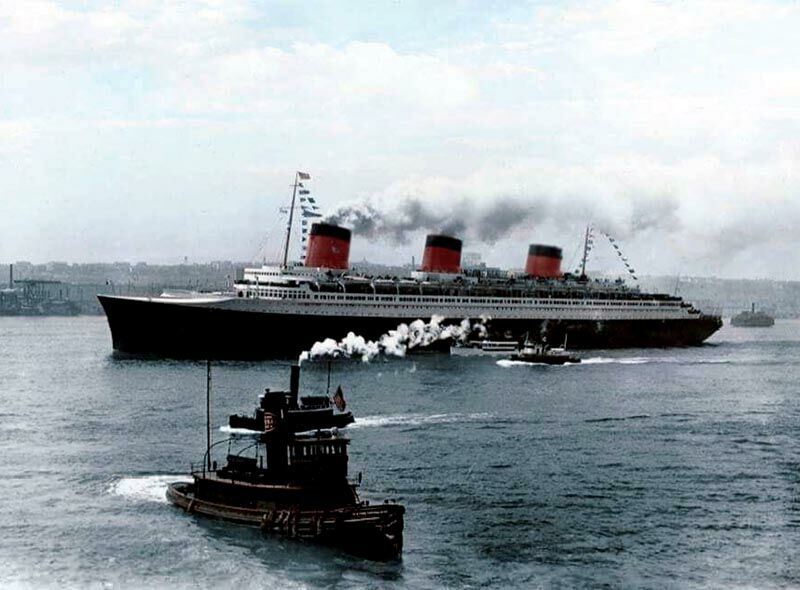
An excellent
photograph of the S.S. Normandie arriving in
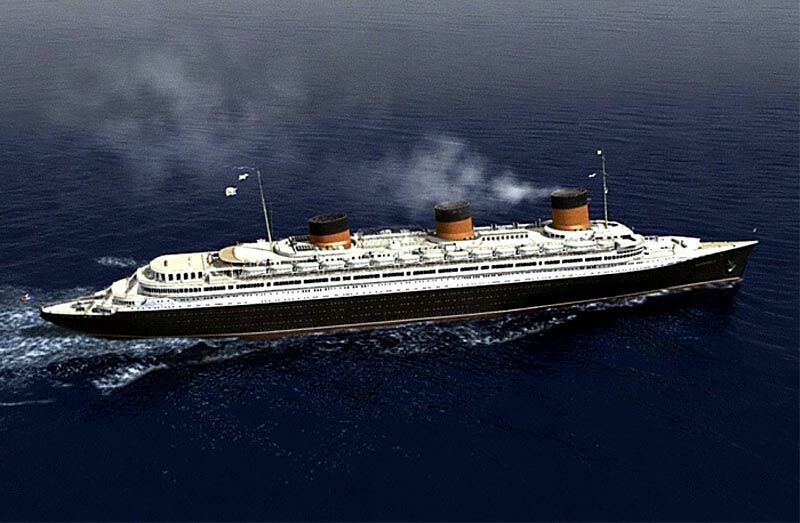
The “Normandie seen at sea after her 1936 refit
*********************
S.S.
Normandie INDEX:
Page One -
Construction, Maiden Voyage & First Class Interiors.
Page Two – Second (Tourist) & Third Class
Interiors, Her Career, WW2 and her sad demise - This Page.
Page Three - Extras
including Deck Plans.
Other
French Line Ships:
S.S. Ile de France - 1927 to
1959.
S.S.
Paris - 1921 to 1939.
“On
Board the Normandie”
To view a
6 minute YouTube “British Pathe”
video of her maiden voyage departure use the link below
S.S. Normandie departs on
her Maiden Voyage
“Blue Water Liners sailing to the distant shores.
I watched them come, I watched
them go and I watched them die.”
Featuring over 1,435 Classic Passenger Liners, Passenger-Cargo Liners & Classic Cruise Ships!
Or ENTER HERE
For interest: Sadly an email service to ssMaritime is no longer available, due to the author’s old age and chronic illness as well as being disabled, etc. In the past ssMaritime received well over 120 emails per day, but Mr. Goossens can no longer handle same. He sincerely regrets this!
*********************
ssMaritime.com & ssMaritime.net
Where the ships of the past make history & the 1914 built M.S. Doulos Story.
The Author has been in Passenger Shipping & the Cruise Industry for well over 60 years
In addition he was the founder of “Save the Classic Liners Campaign” in 1990.
Please Note: ssmaritime and associated sites are 100% non-commercial and the author seeks no funding or favours of any shape or form, never have and never will!
Photographs on ssmaritime and associate pages are by; the author or from the author’s private collection. In addition there are some images that have been provided by Shipping Companies and private photographers or collectors. Credit is given to all contributors. However, there are some photographs provided to me without details regarding the photographer/owner concerned.
This notice covers all pages; although, and I have done my best to ensure that all photographs are duly credited and that this notice is displaced on each page, that is, when a page is updated!
ssMaritime is owned & © Copyright by Reuben Goossens - All Rights Reserved

